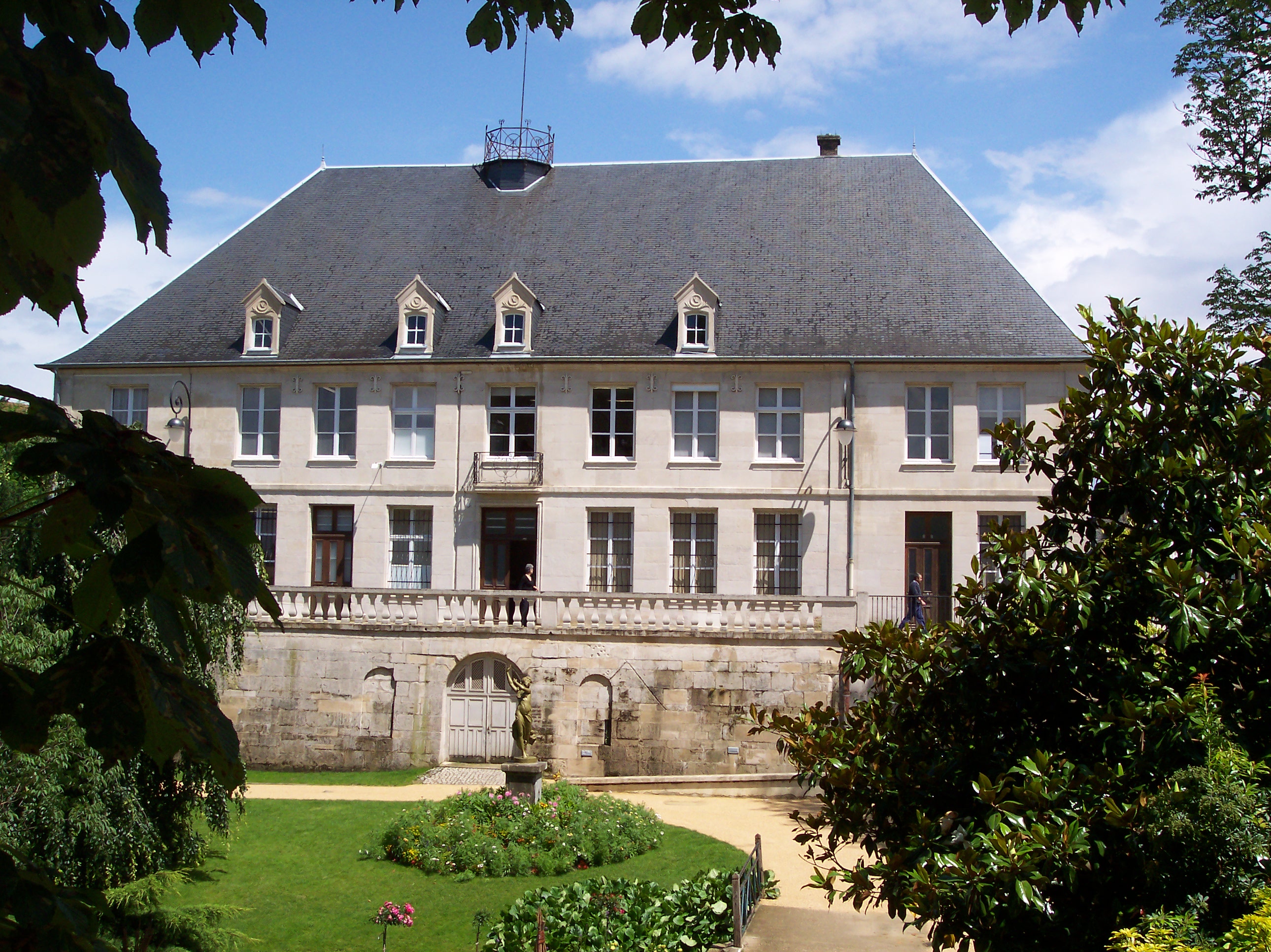
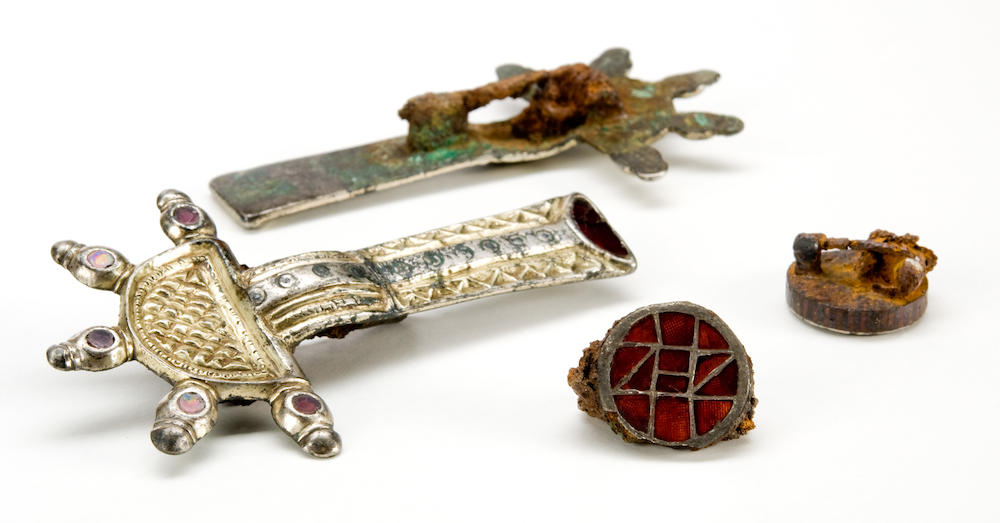
(1/ )
Early Middle Ages [476 / 1000]
Two asymmetrical annealed fibulae and two circular cloisonné fibulae from the Merovingian period (6th century AD). These jewels were discovered in Saint-Dizier, in Haute-Marne, in the tomb of a richly adorned Franconian teenager. The first ones are made of silver, their head is extended by five extremities inlaid with a semi-circular garnet and their foot with a rectangular garnet. The second ones, found on the neck of the deceased, have a cloisonné decoration of garnets. Their rim is decorated with a copper damascene.
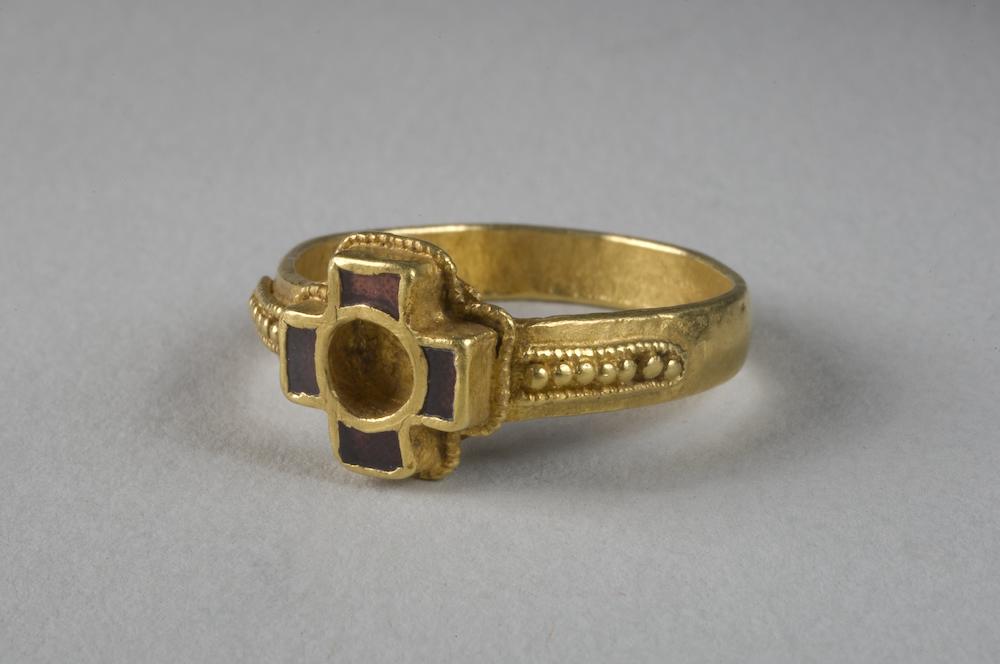
(2/ )
Early Middle Ages [476 / 1000]
Gold and garnet ring, Merovingian period (6th century A.D.). The cruciform head, surrounded by a gold filigree, is formed by a cloisonné decoration of four rectangular garnets, each representing a branch of the cross. The garnets are native to India. The central gold cavity, which is now empty, contained an ornament, perhaps in mother-of-pearl. It was discovered in Saint-Dizier, in Haute-Marne, in the tomb of a richly adorned Franconian teenager.
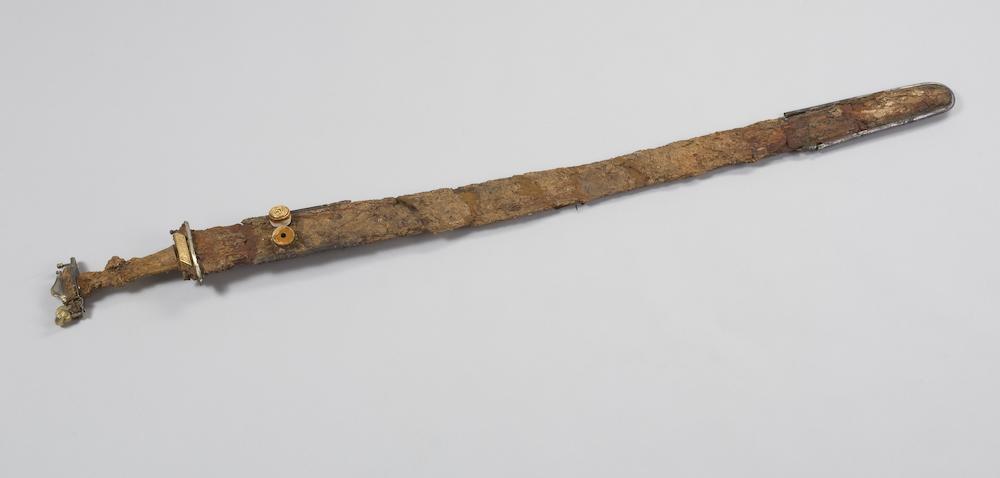
(3/ )
Early Middle Ages [476 / 1000]
between 530 and 570 iron, silver, gold, wood (scabbard), cloth (on the bolt), leather (on the wood of the scabbard), fur (on the wood of the scabbard) The wooden scabbard is present. It is covered with leather, of which only a few fragments are preserved near the gutters and the bouterolle. Traces of fur are visible under the layer of wood. The pommel is solid, silver, decorated with niello engravings and gilded. A decorative rivet in gilded silver is present. There is a double ring in gilded silver, solid and incised.
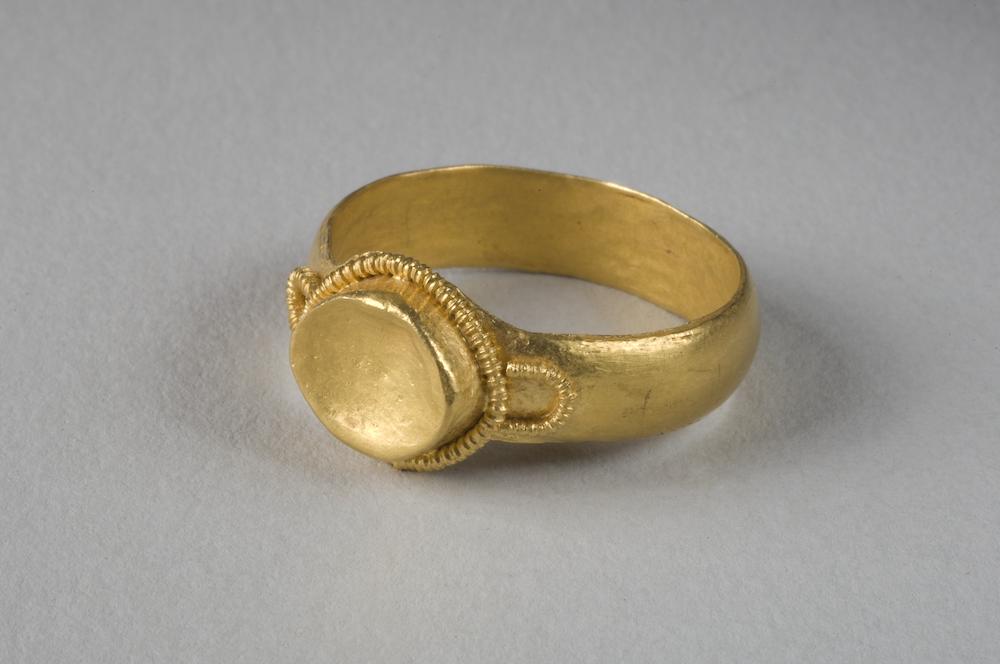
(4/ )
Early Middle Ages [476 / 1000]
Gold ring, with flat bezel and gold filigree on the shoulders, from the Merovingian period (6th century A.D.). It was discovered in Saint-Dizier, in Haute-Marne, in the burial chamber of a member of the high Frankish aristocracy, on the site of the right hand of the deceased.
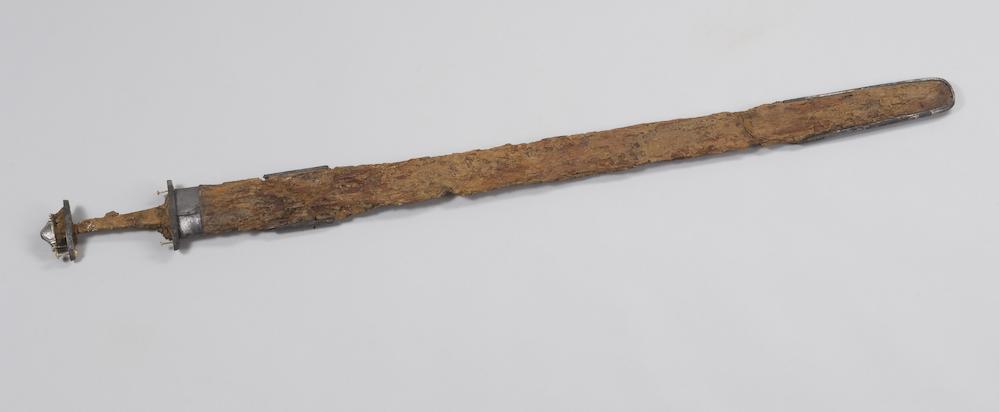
(5/ )
Early Middle Ages [476 / 1000]
between 530 and 570 iron (weapon), silver (scabbard, suspension gutter), gold (rivets at the entrance to the scabbard and pommel), wood (alder), leather, fur, ivory, stone, cloth The wooden scabbard is present. It was covered with leather, of which only a few fragments are preserved near the gutters and the bolt. Traces of fur are visible under the layer of wood. The bouterolle is made of thin silver plate (approx. 0.2 mm), with a riveted fret and gutter. It is worn at its distal end.
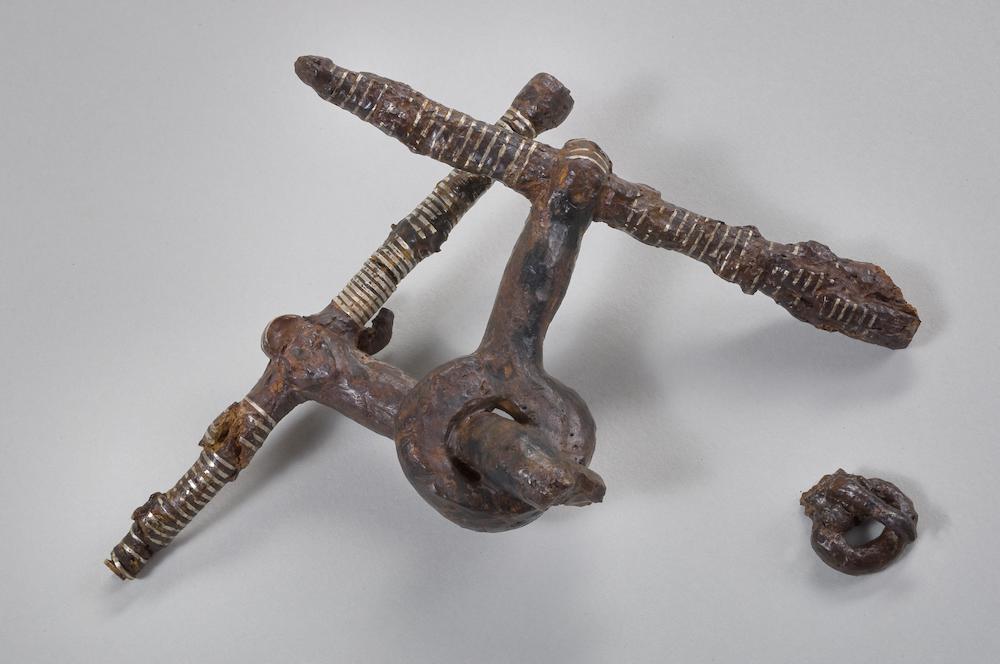
(6/ )
Early Middle Ages [476 / 1000]
Horse bit dated between 470 and 610

(7/ )
Early Middle Ages [476 / 1000]
Soldier's Grave
Llong javelin with a short wooden shaft, the angon is characteristic of the offensive equipment of the Frankish warrior. This one, dated between 470 and 530, was found in the necropolis of Saint-Dizier in the Haute-Marne. The weapons of this period are rarely isolated in the burials, but on the contrary constitute a defensive and offensive panoply. In this period it is possible to discover in the same burial one or more of the following elements: angons, spearheads, shields, arrowheads, scramasaxes, axes, long swords. These weapons may also be accompanied by ritual funerary deposits and objects related to the mortuary clothing of the deceased. The study of these burials is particularly rich in information on military equipment and therefore on the practice of warfare in the Merovingian period. They also provide valuable clues to the economic and social level of the deceased during this period, with the warrior burials often being among the wealthiest.
Between 470 and 530 iron (angon), copper alloy (tip and fret decoration), wood (in the socket and rest of the shaft) Iron shaft with a round cross-section at the distal end and an octagonal cross-section at the other. The point of the weapon is diamond-shaped in section and bears a damascened copper alloy leaf, as well as incised decoration.
.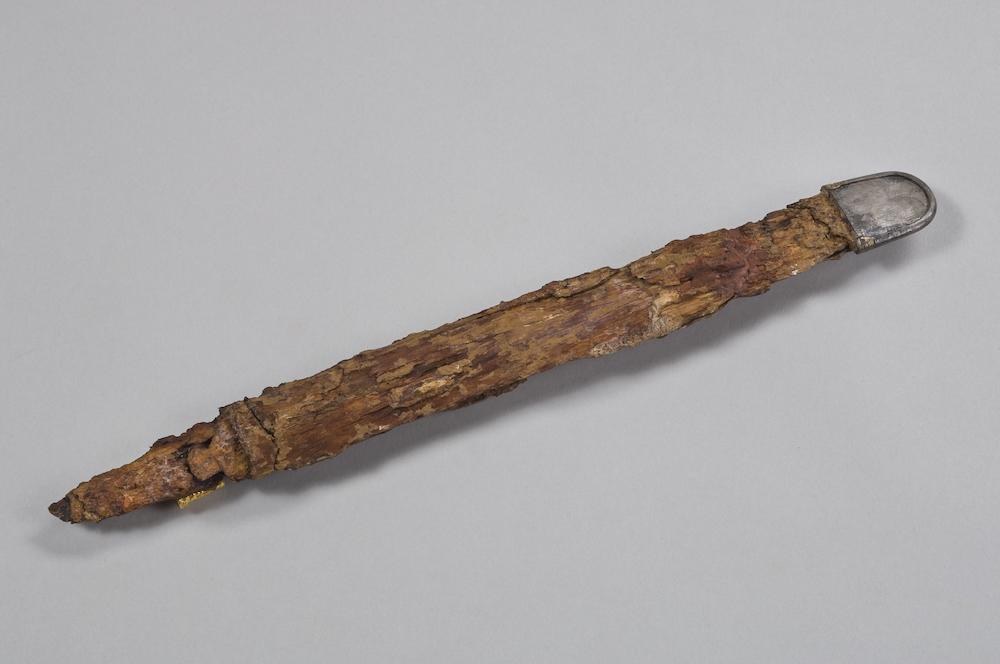
(8/ )
Early Middle Ages [476 / 1000]
between 560 and 610 silver (bouterolle), gold (bouterolle gutter), wood (alder), niello (bouterolle) Small scramasaxe of the large knife type with a triangular blade (sharp on one side only) set in a fully preserved wooden scabbard.

(9/ )
Early Middle Ages [476 / 1000]
Both a weapon and a tool
Pamong the offensive weapons used for military purposes during the High Middle Ages (between the fifth and tenth centuries) was the scramasax, which reached its peak in the Merovingian period. Made of iron alloy and silver, this small scramasaxe is a large knife with a triangular blade, sharp on one side only, set in an exceptionally well-preserved wooden sheath. This versatile tool could have had several functions, and could have been used as a machete for example. The excavation revealed that this was an exceptional funerary complex because of its richness in furnishings and the particular layout of the male tombs, leaning against a horse grave. In addition, the surrounding soil, a moist clayey silt, allowed for the good preservation of organic remains (wood, leather, fur, cloth) that were in contact with the metal objects.
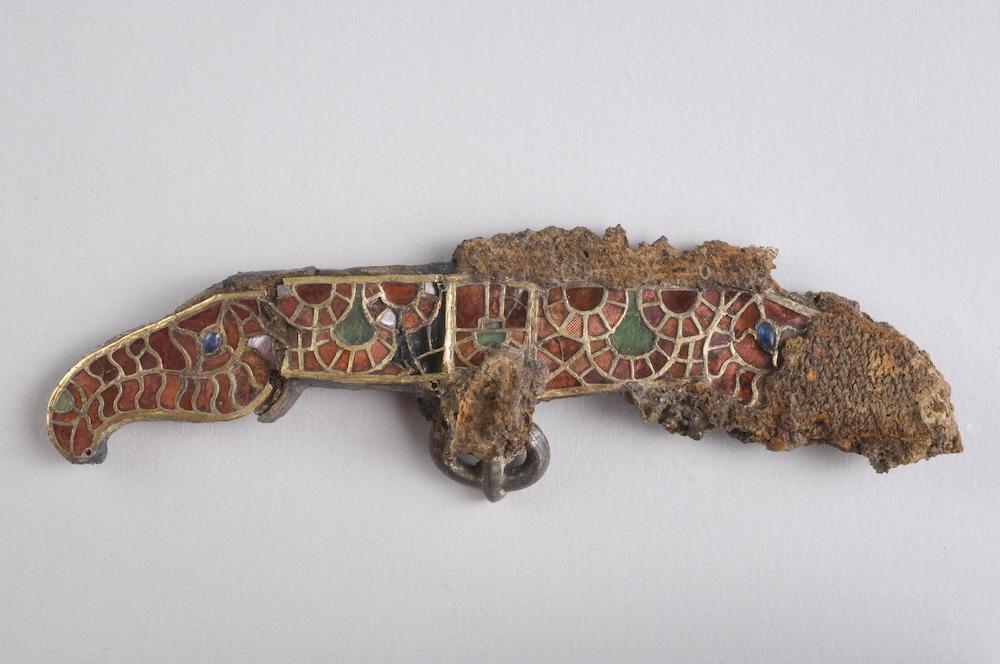
(10/ )
Early Middle Ages [476 / 1000]
Clasp of a chaplain (purse worn at the belt) of the Merovingian period (6th century AD). It presents a gold decoration cloisonné with garnets and glass showing horses' heads. The central field of the clasp is inlaid with lapis lazuli. This chaplain's clasp was found in Saint-Dizier, Haute-Marne, in the burial chamber of a member of the high Frankish aristocracy, in the place of the deceased's back.
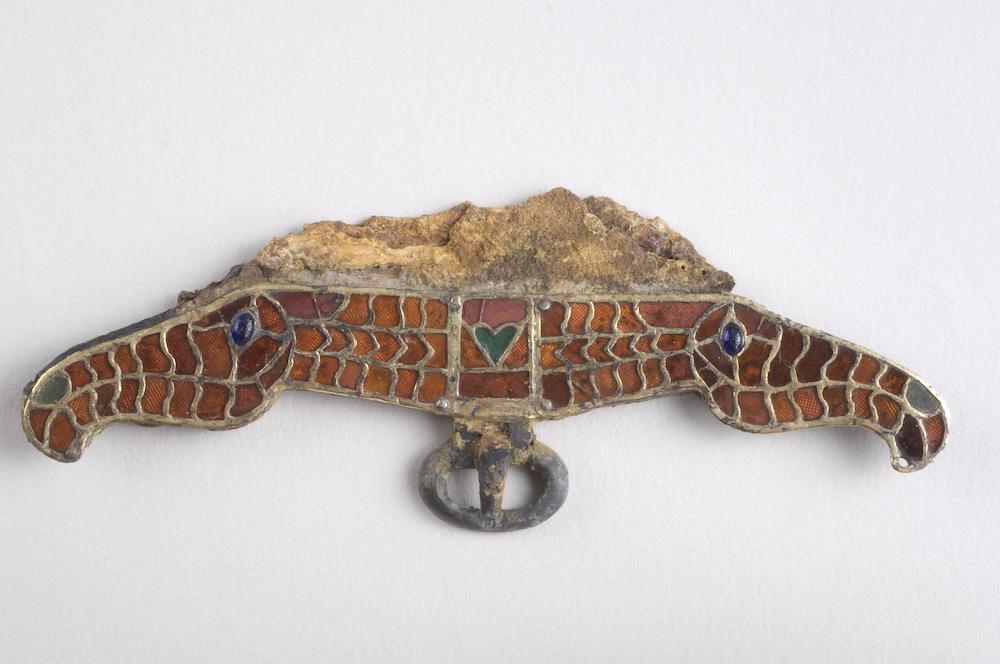
(11/ )
Early Middle Ages [476 / 1000]
between 470 and 570 iron (case of the cloisonné, barb of the buckle), silver, (pearl, rivets, buckle), gold (pearl), glass (eyes and nostrils), garnet, wood (clasp reverse), fabric, leather (on the reverse old calf) Clasp of aumônière with the ends curved in horse head. The decoration consists of cloisonné garnets and green and blue glassware. The buckle is oval and truncated cone-shaped pin straight. Clasp cloisonné with sealing garnets and glass.
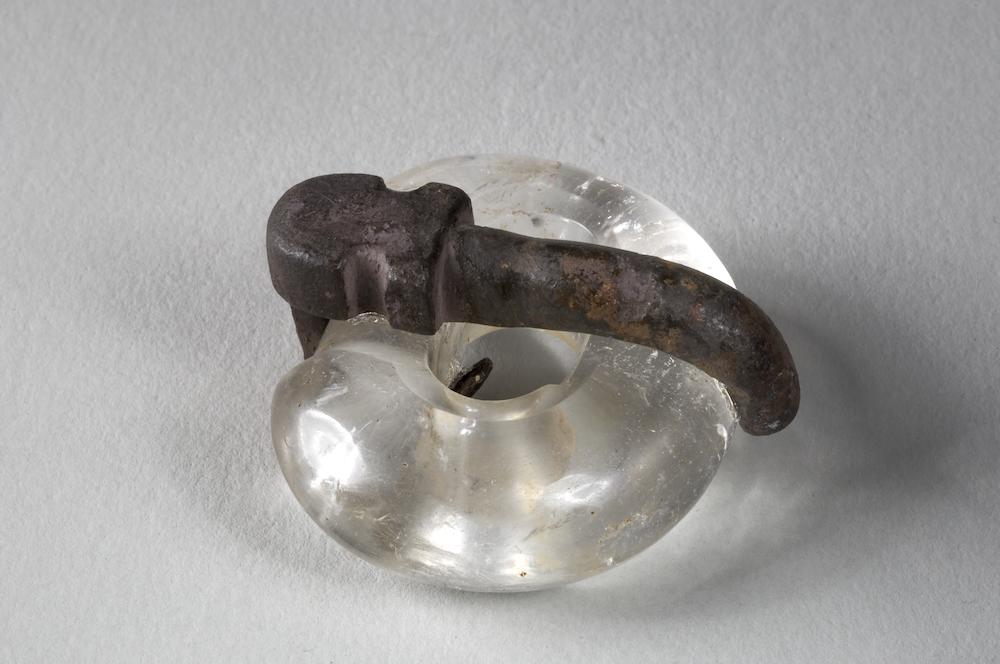
(12/ )
Early Middle Ages [476 / 1000]
Oval belt buckle made of rock crystal and silver with a shield-shaped base, from the Merovingian period (6th century AD). It was part of a rich collection of furniture found at Saint-Dizier, in the Haute-Marne, in the burial chamber of a young man of the Frankish aristocracy.
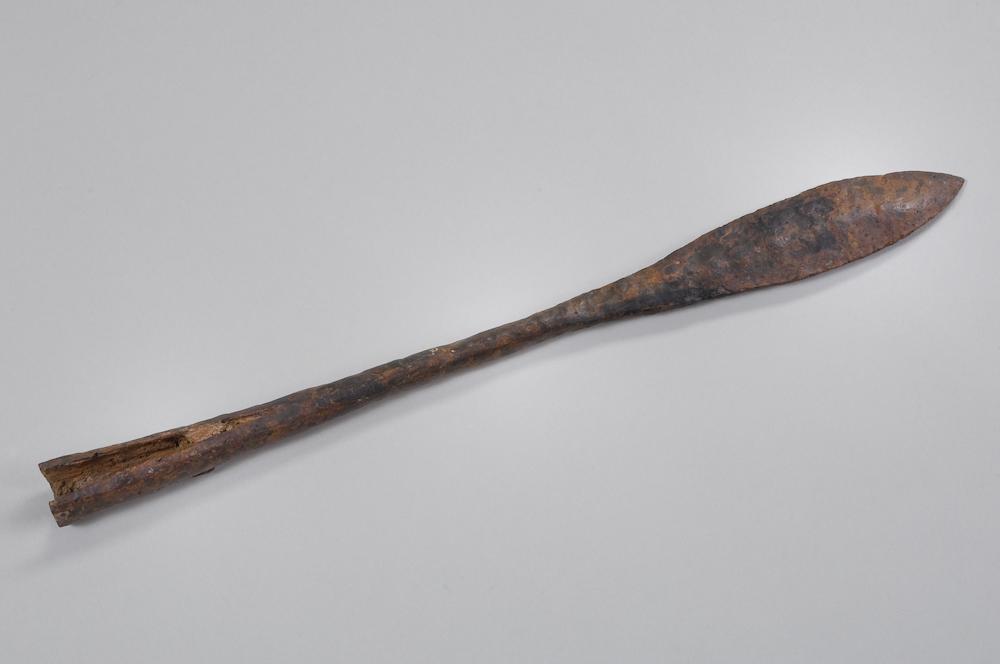
(13/ )
Early Middle Ages [476 / 1000]
between 470 and 610 iron, wood (ash) Long spearhead with short flame and open socket. Presence of a rivet in the middle part of the socket.
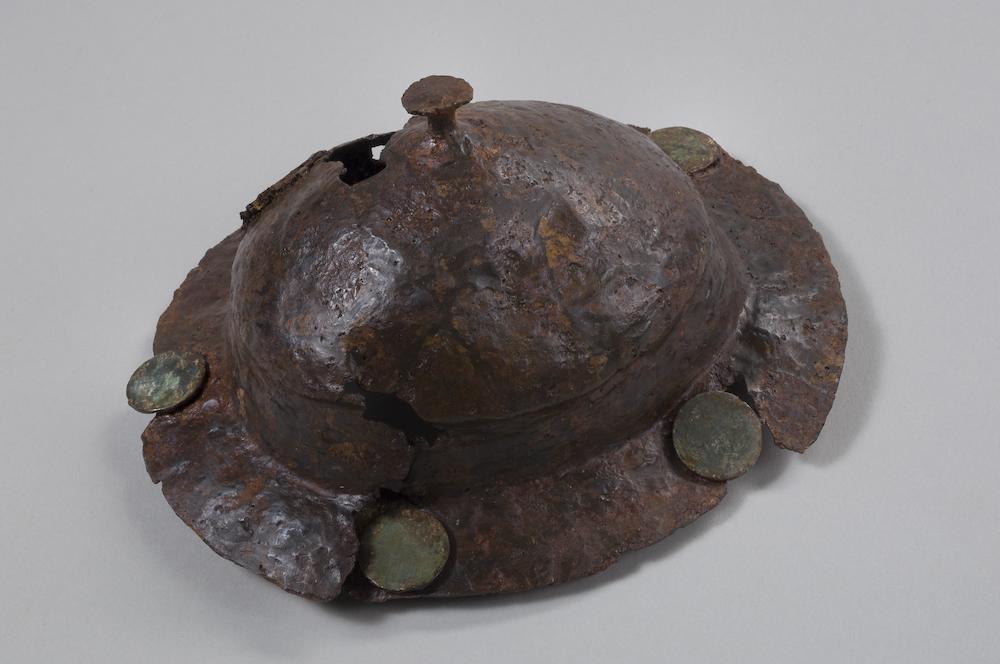
(14/ )
Early Middle Ages [476 / 1000]
Round conical umbo topped by a point ending in a flat disc (diam. 1.5 cm) and fixed to the wooden part of the shield by 5 rivets. Works with the manipule.
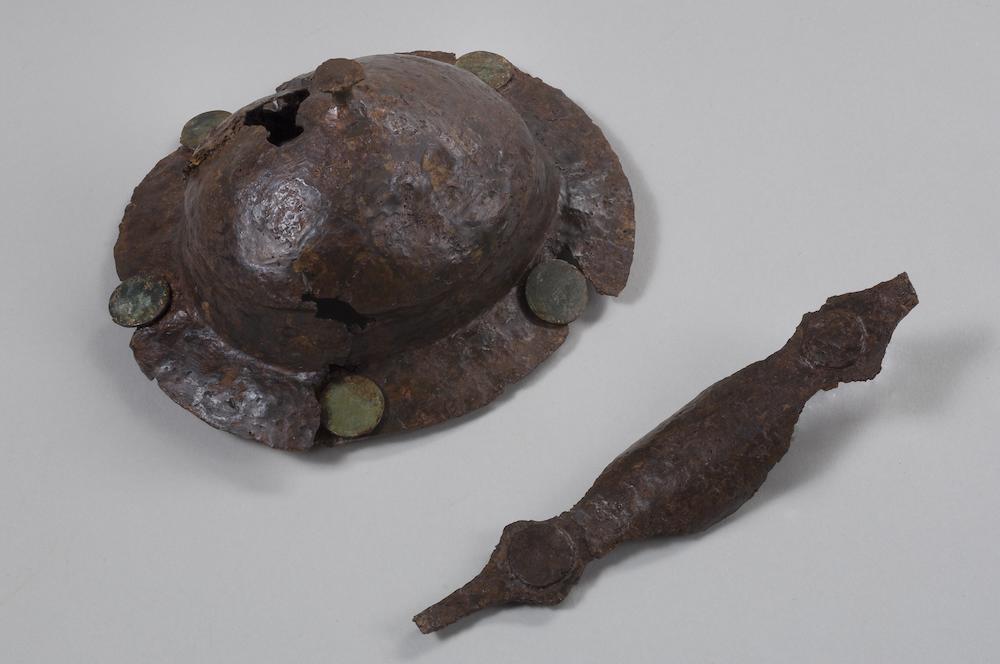
(15/ )
The manipule is made of a thin iron sheet, maintained by two iron rivets. Traces of wood on the back of the rivets and in the hollow part of the handle. The wood in the hollow part of the handle may correspond to a wooden handle (covered with leather?). The handle is not repositionable on the umbo because of the deformations. Works with the umbo object 11. - 1 fragment of a rectangular section rod could be a remnant of a manipule branch. - 1 fragment of an iron rivet with a square head (dim. 1 cm) could be linked to a repair of the maniple ? -1 fragment of a thick quadrangular section rod (remainder of a nail or rivet?)
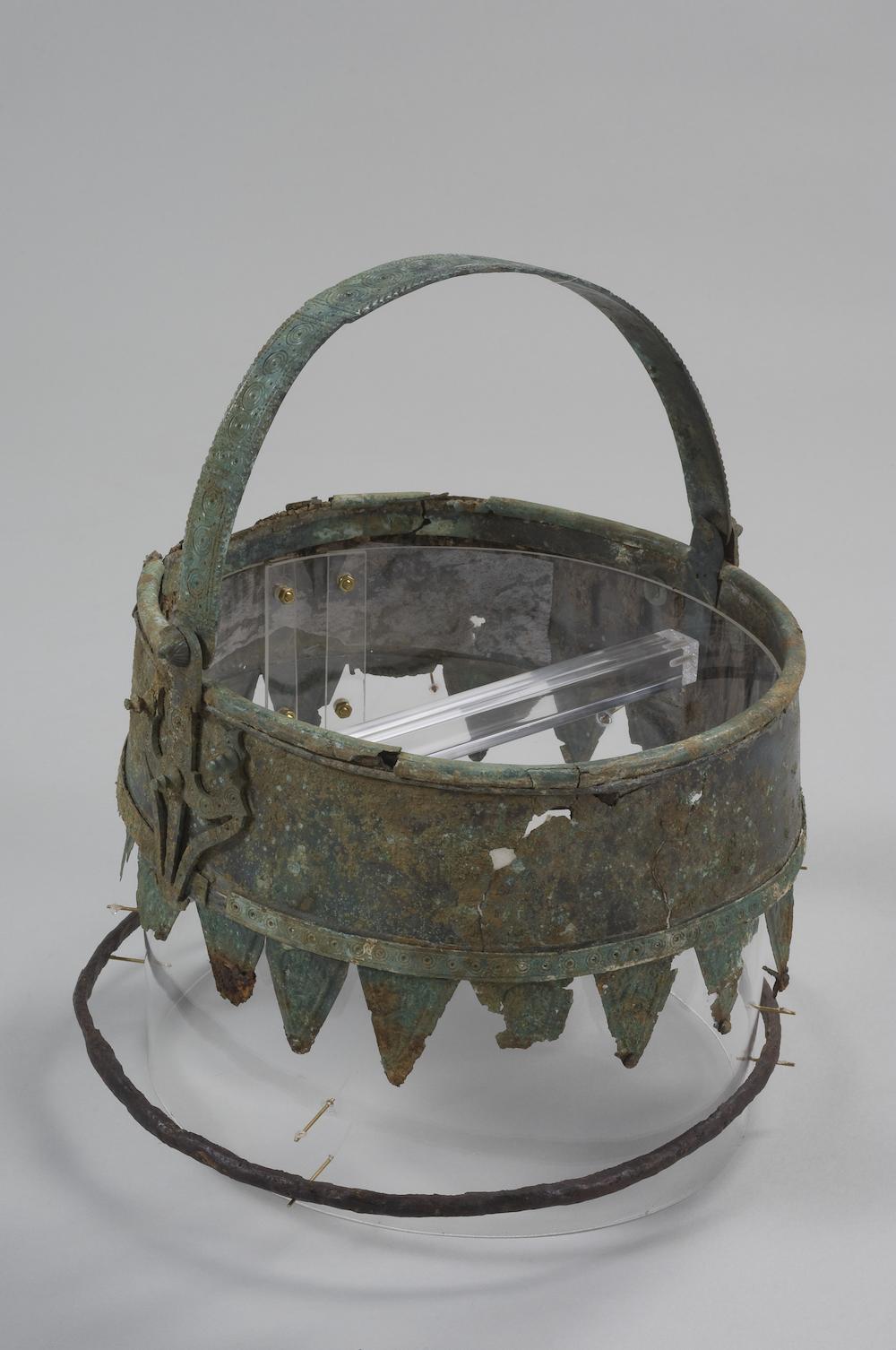
(16/ )
Early Middle Ages [476 / 1000]
between 440 and 530 copper alloy (handle and upper ring), wood, iron (3 rings), wood (6 fragments of staves) Truncated cone-shaped bucket with iron frame and copper alloy. The wood was not completely preserved, and the iron straps were found collapsed one on top of the other.

(17/ )
Early Middle Ages [476 / 1000]
The basin is of circular shape with a rim in marli with pearl decoration. It rests on a base originally welded
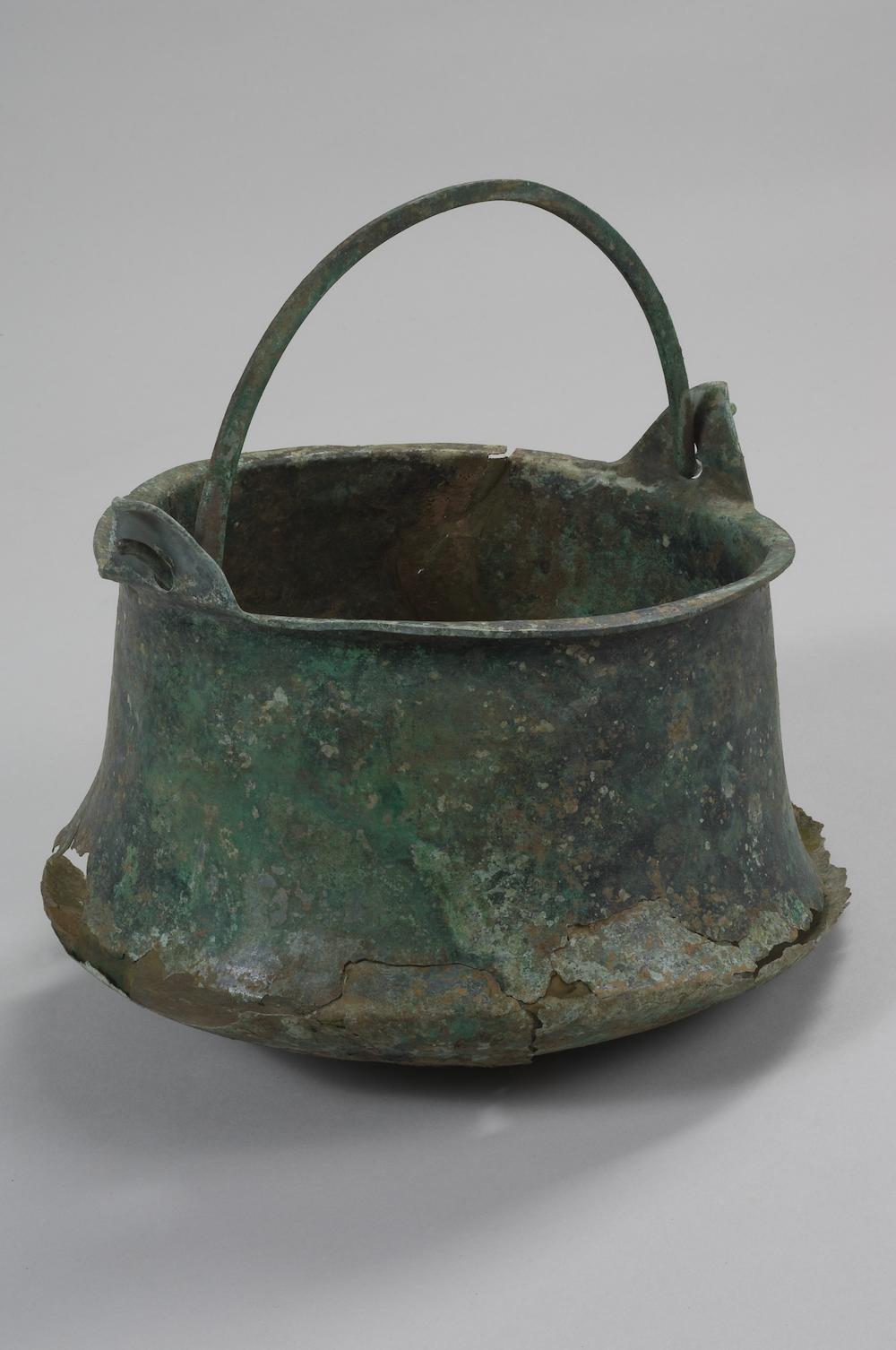
(18/ )
Early Middle Ages [476 / 1000]
The handle, massive is of quadrangular section is articulated around triangular brackets. Cauldron with circular side and widened base in the shape of a bowl.
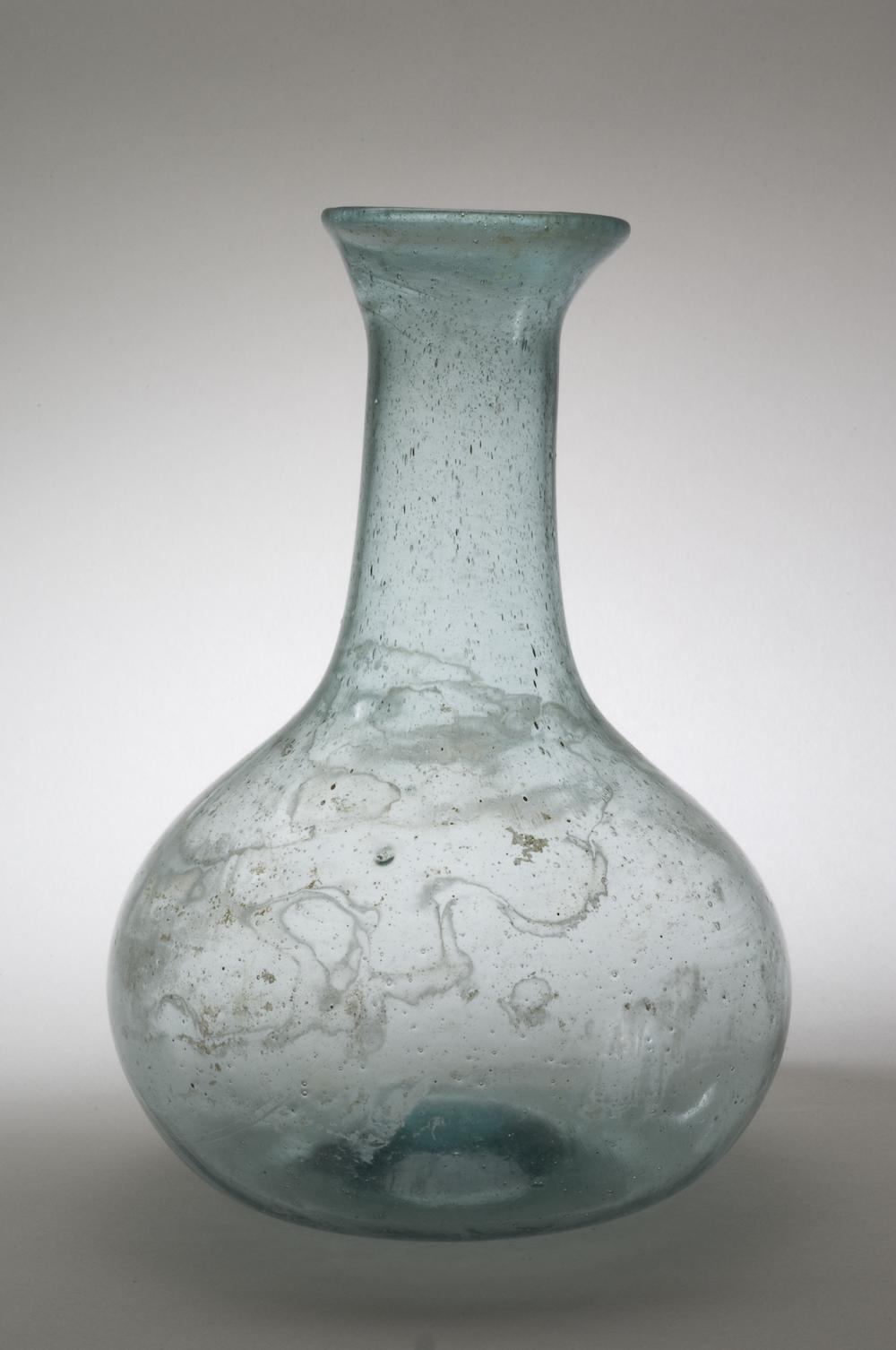
(19/ )
Early Middle Ages [476 / 1000]
between 440 and 530 Bottle in transparent bluish glass with many small bubbles. The body is rounded. The cylindrical neck ends in a flared opening with a round lip.
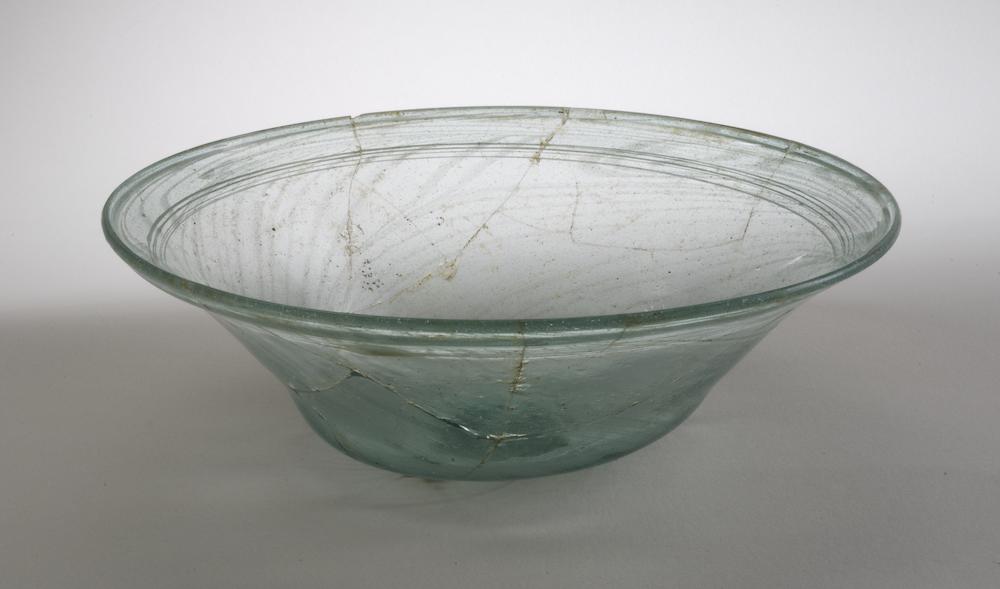
(20/ )
Early Middle Ages [476 / 1000]
between 440 and 480 Cup in transparent bluish glass. The lip is round and the bottom slightly upset with the trace of a tubular pontil of elliptical section. The decoration consists of 5 turns of opaque white glass nets under the lip but also of a very particular decoration which uses entirely the filanders
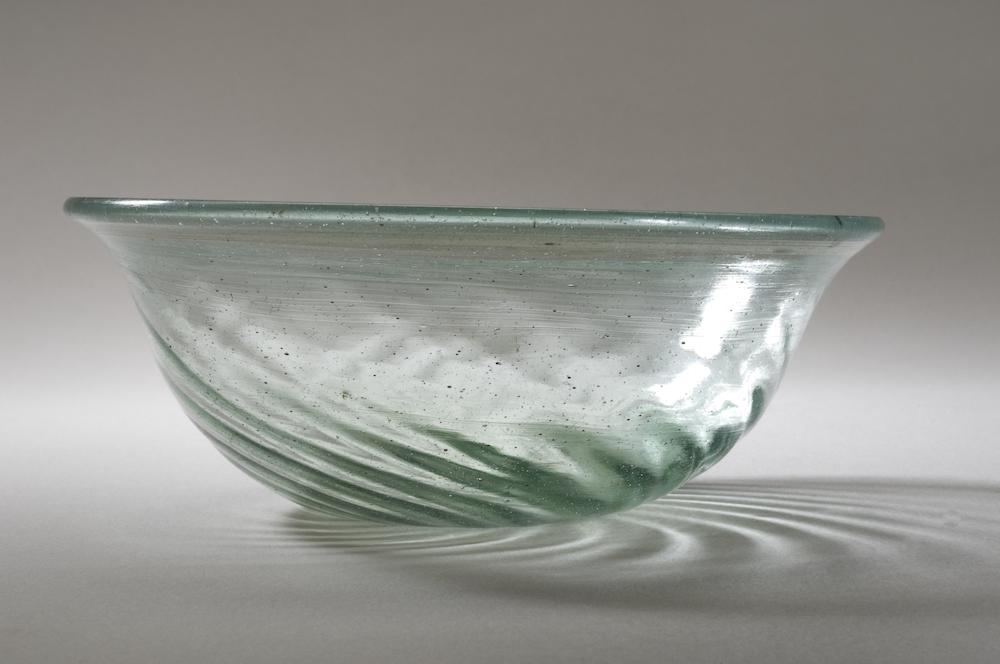
(21/ )
Early Middle Ages [476 / 1000]
between 400 and 520 This glass bowl is of green-water tint, transparent, with some bubbles but of excellent quality, without any trace of iridescence.
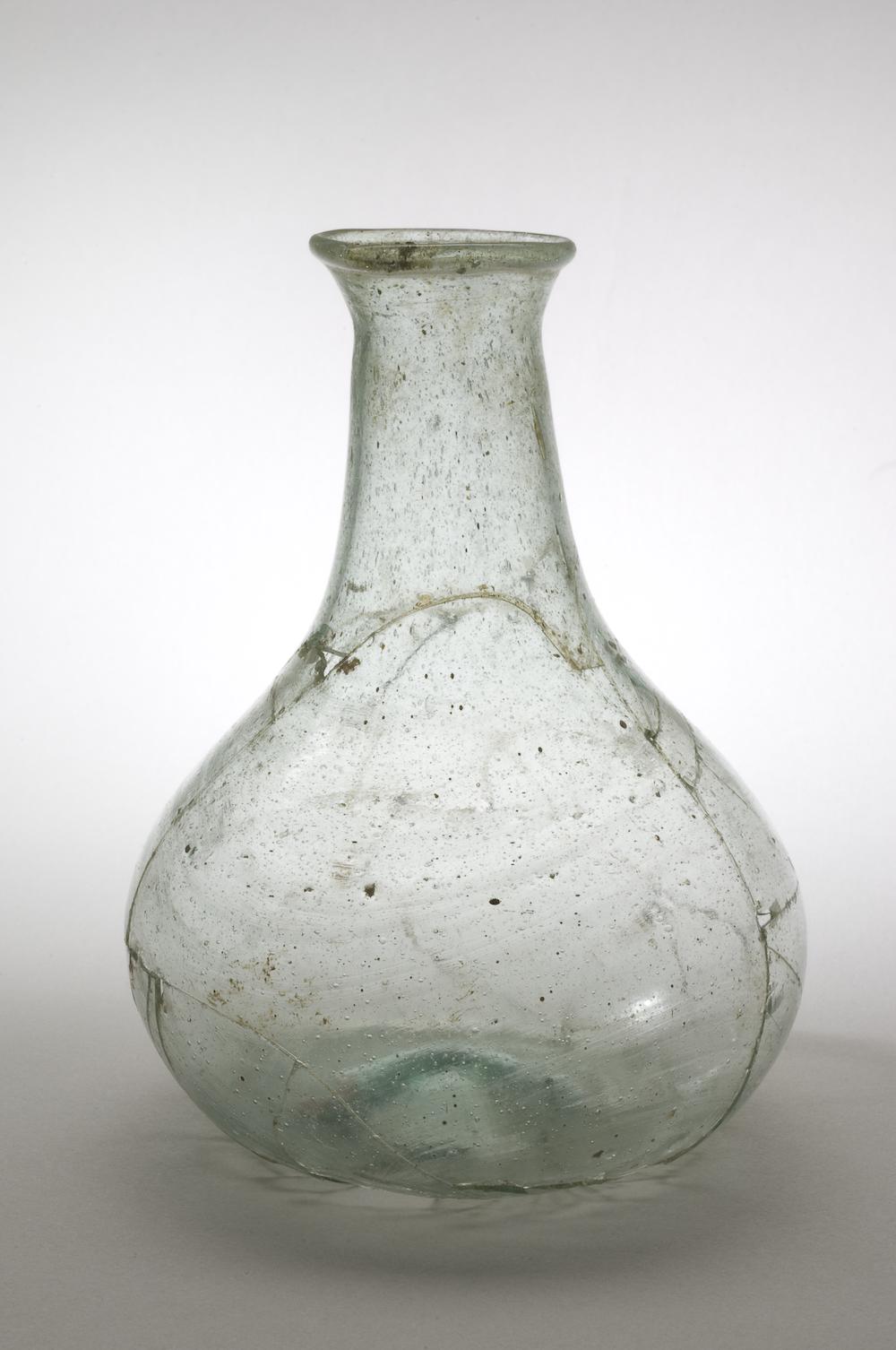
(22/ )
Early Middle Ages [476 / 1000]
This bluish transparent glass bottle contains some bubbles and filanders. The lip is hemmed towards the inside in a very irregular way. The body is piriform, with a conical neck and a flared opening.
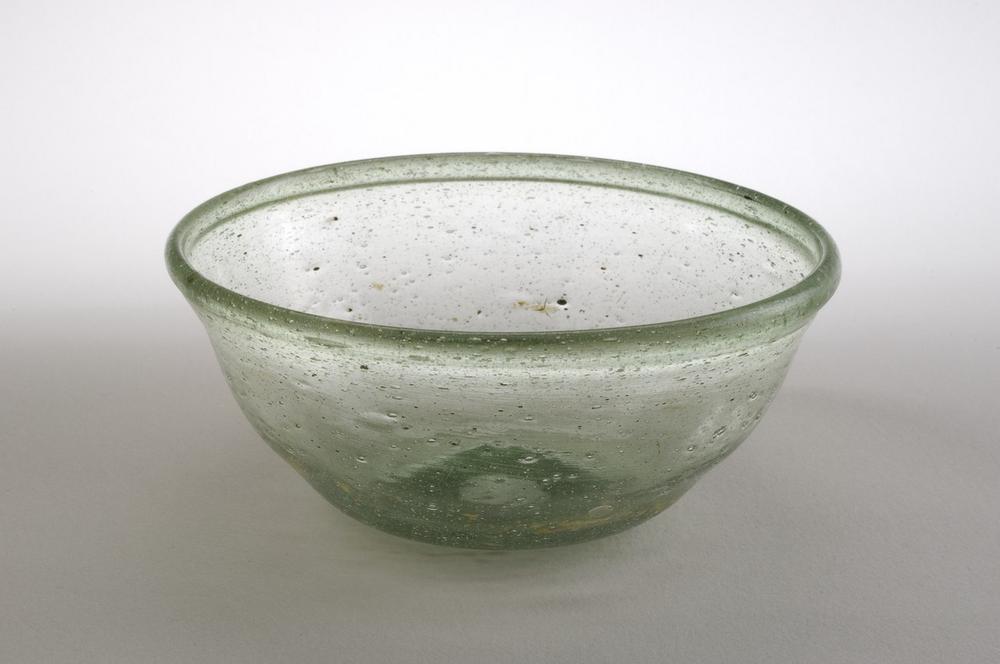
(23/ )
Greenish glass cup containing many small bubbles. The lip is round and well marked. The wall of the body is quite thick and the slightly upturned bottom bears a tubular pontil mark with a diameter of 16 mm projecting from the bottom.
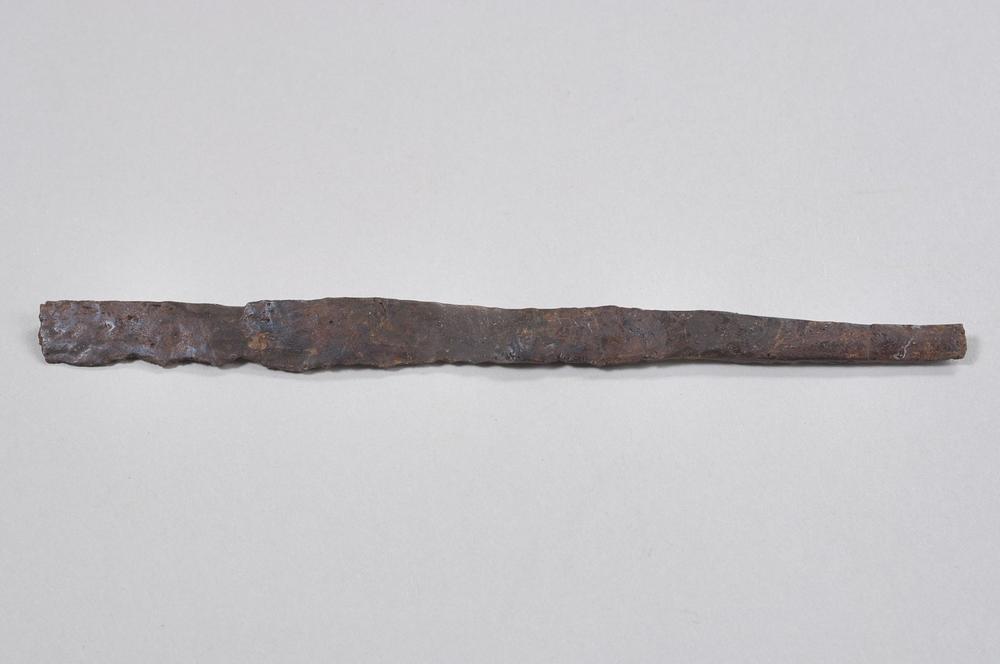
(24/ )
Fragment of a knife, originally located under the clasp of the aumônière (object 35). The blade is not very wide but thick. Silk of rectangular section. It is very deformed by corrosion.
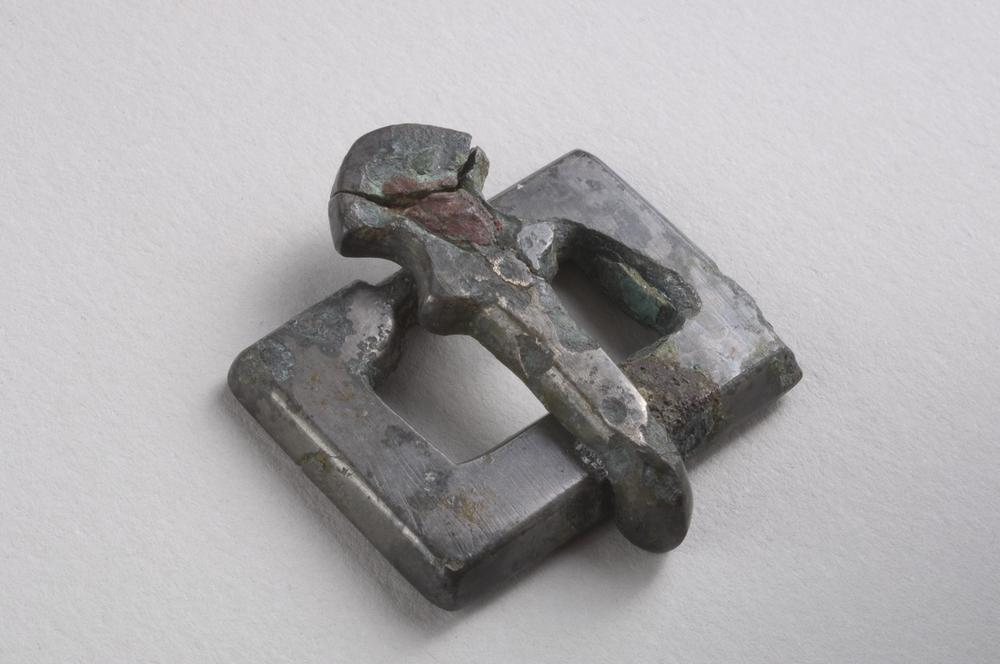
(25/ )
Rectangular buckle with bevelled edges and scutiform pin. Rectangular buckle with traces of polishing. Remains of iron corrosion products at the end of the barb. It is rough cast on the reverse. The face has traces of polishing. The clasp is made of iron, square in section, and its corrosion has caused the shield to break. The copper alloy is cast around this hoop.
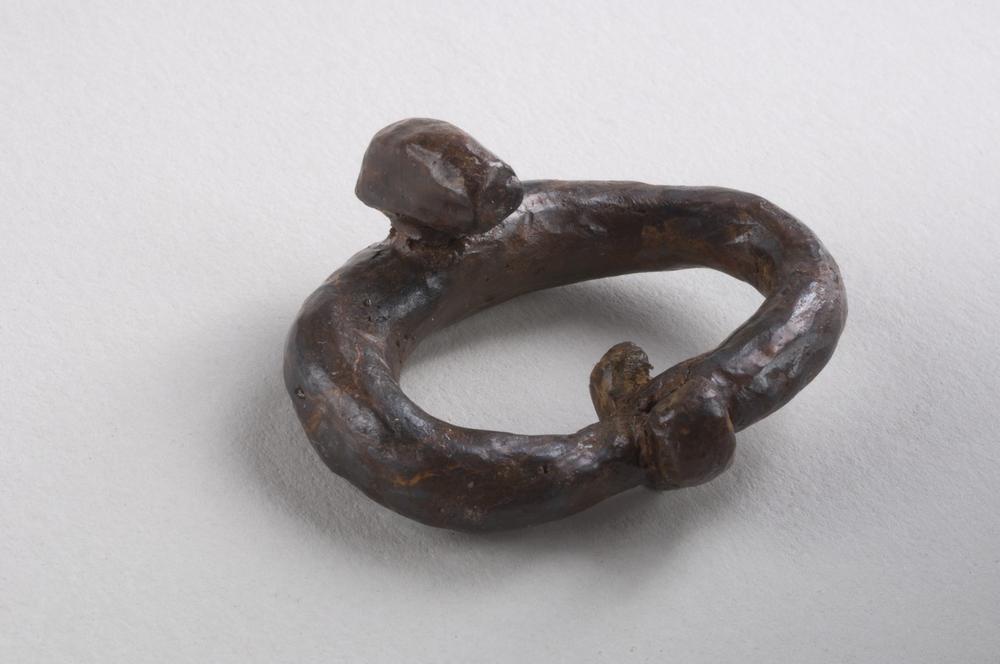
(26/ )
Oval buckle of semi-circular section. The barb is not preserved. Observations: this object is incomplete. Buckle with two fragments of the pin stuck by corrosion.
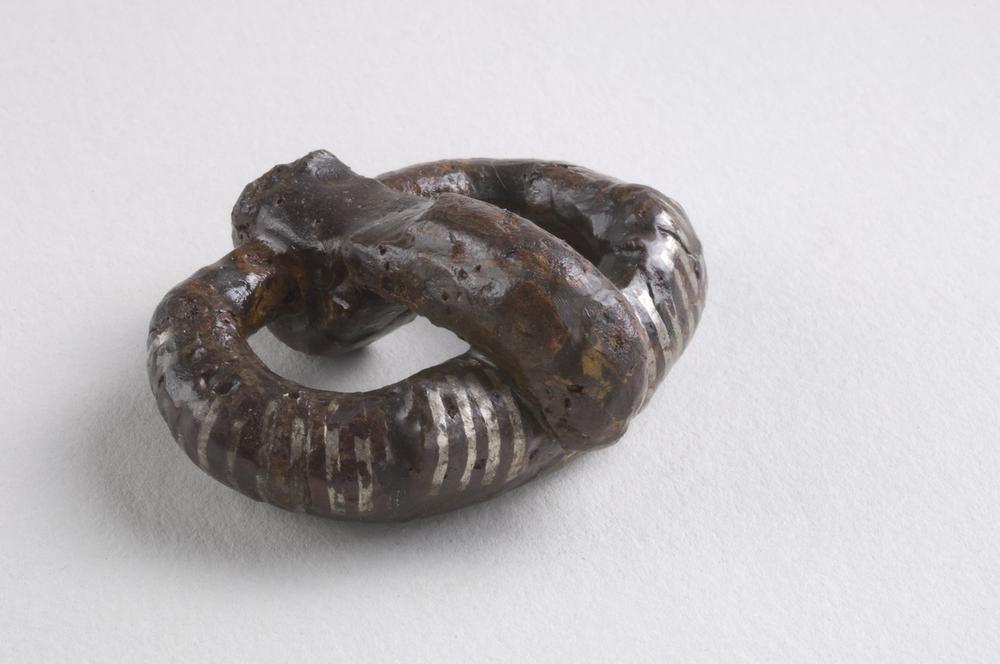
(27/ )
Oval buckle with solid straight pin and damascene decoration of silver wire. Observations: this object is incomplete.
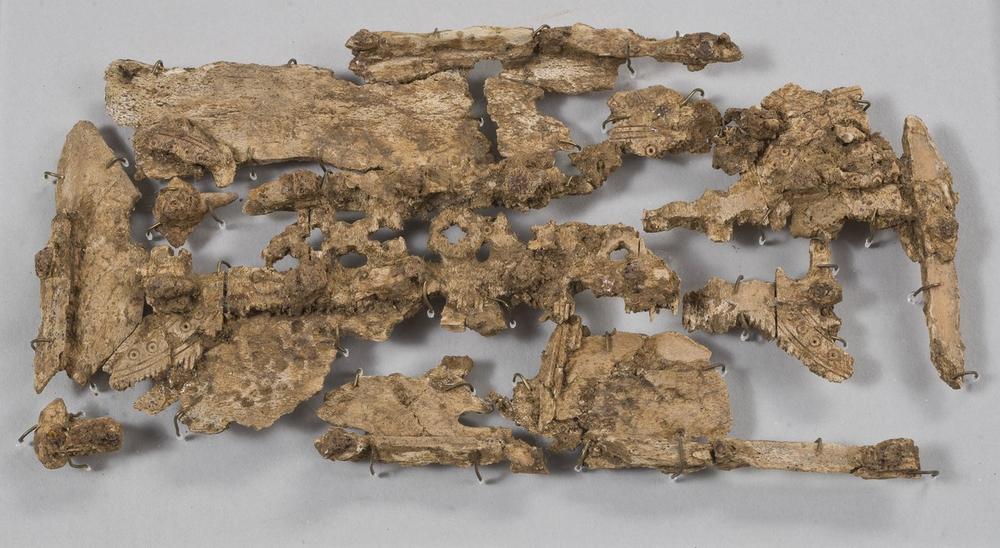
(28/ )
The comb is composed of juxtaposed plates held together by 4 bars connected 2 by 2 by rivets. The comb is composed of juxtaposed plates held together by 4 bars connected 2 by 2 by rivets. This system of rivets is also used in the manufacture of the case. Remains of red polychromy are still visible in several places on the surface of the object and inside the engraved decorations. The comb has been broken into many pieces, eight of which are larger, and has become extremely fragile and difficult to handle. Each manipulation leads to inevitable losses of the material which crumbles. This comb was found more or less in place in its case. The decoration of the comb and the case is essentially composed of double engraved lines (for the comb) and triple lines (for the case) accompanied by a motif of ocelli of different sizes. There is also an openwork quatrefoil design in the central part of the comb.
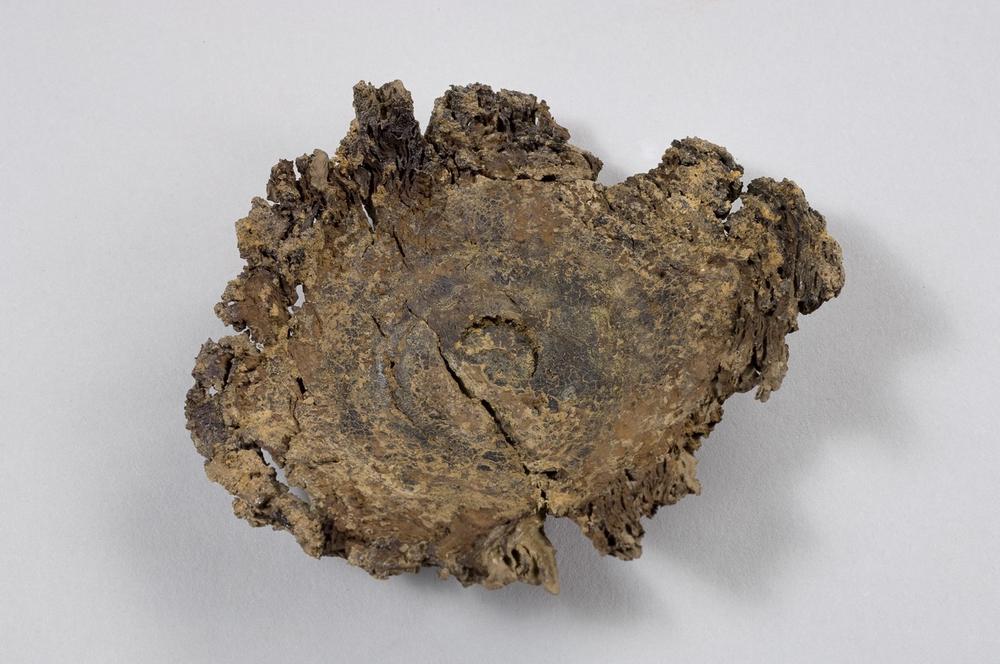
(29/ )
Fragmentary maple wood bowl of shallow flared shape. Observations: this object is fragmentary. Found in cauldron 19, in "support" of flask 40.
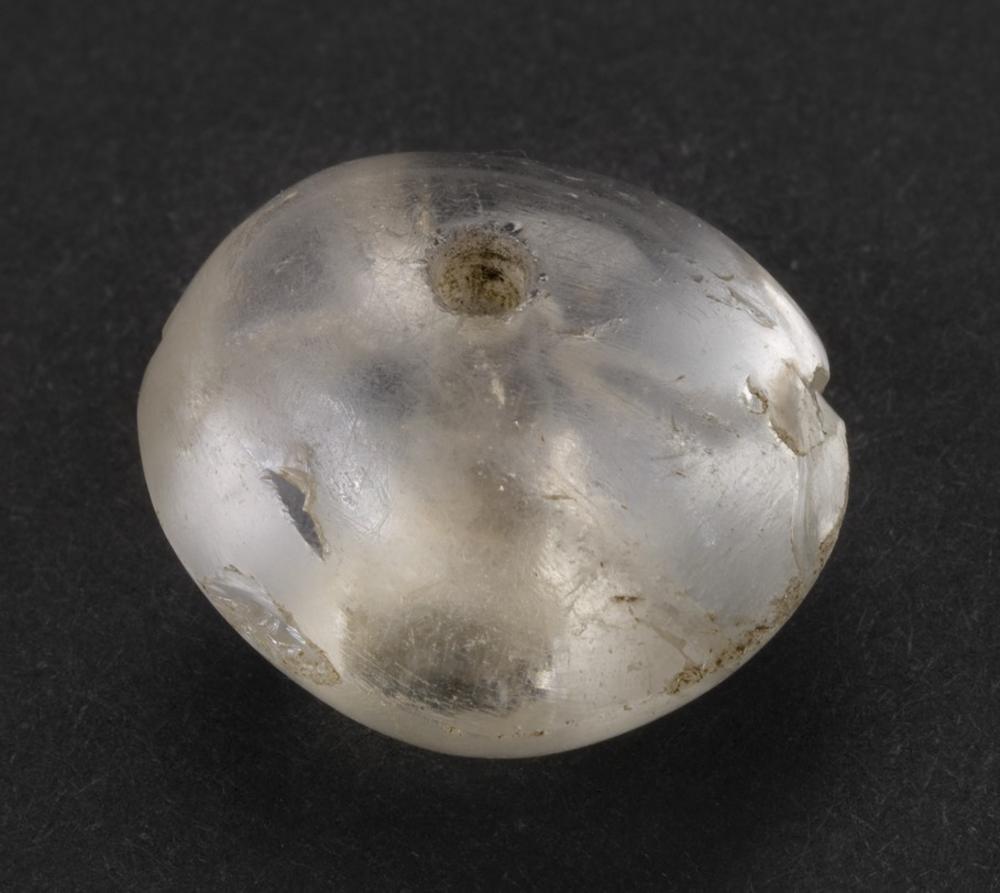
(30/ )
The size of the pearl is not very careful and the polishing not very fine. It was suspended by a knotted silver alloy wire. Two fragments are preserved. The stems are circular in section. The bead was attached to the necklace or garment by means of a metal wire which was closed by winding it on itself.

(31/ )
Bead of circular form. Bead of cord, linked to the belt and worn here in association with a knife. Observations: this object is incomplete. The surface is very altered. A small portion of the original surface is preserved.
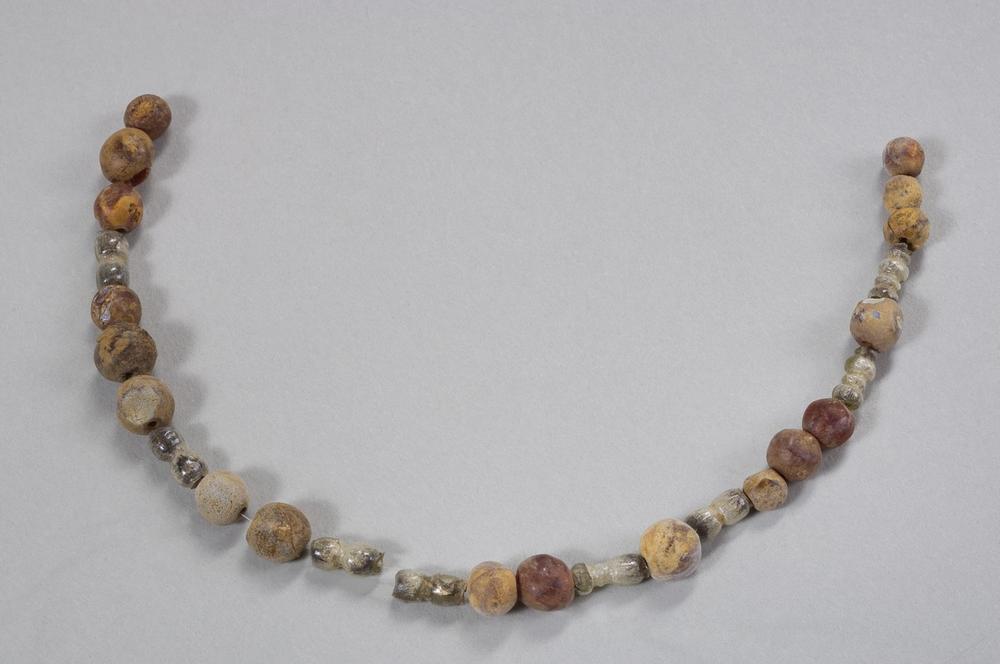
(32/ )
Necklace made of cylindrical beads with two flattened sides, cylindrical beads, cylindrical beads separated by an annular bead and a bead of a unique type on the site and not referenced in a completely identical way, a bead consisting of a cylindrical bead connected by a constriction to a more or less ovoid bead: is this a manufacturing failure? The gilding of the glass is obtained by the inclusion of a thin gold leaf between two layers of molten glass.
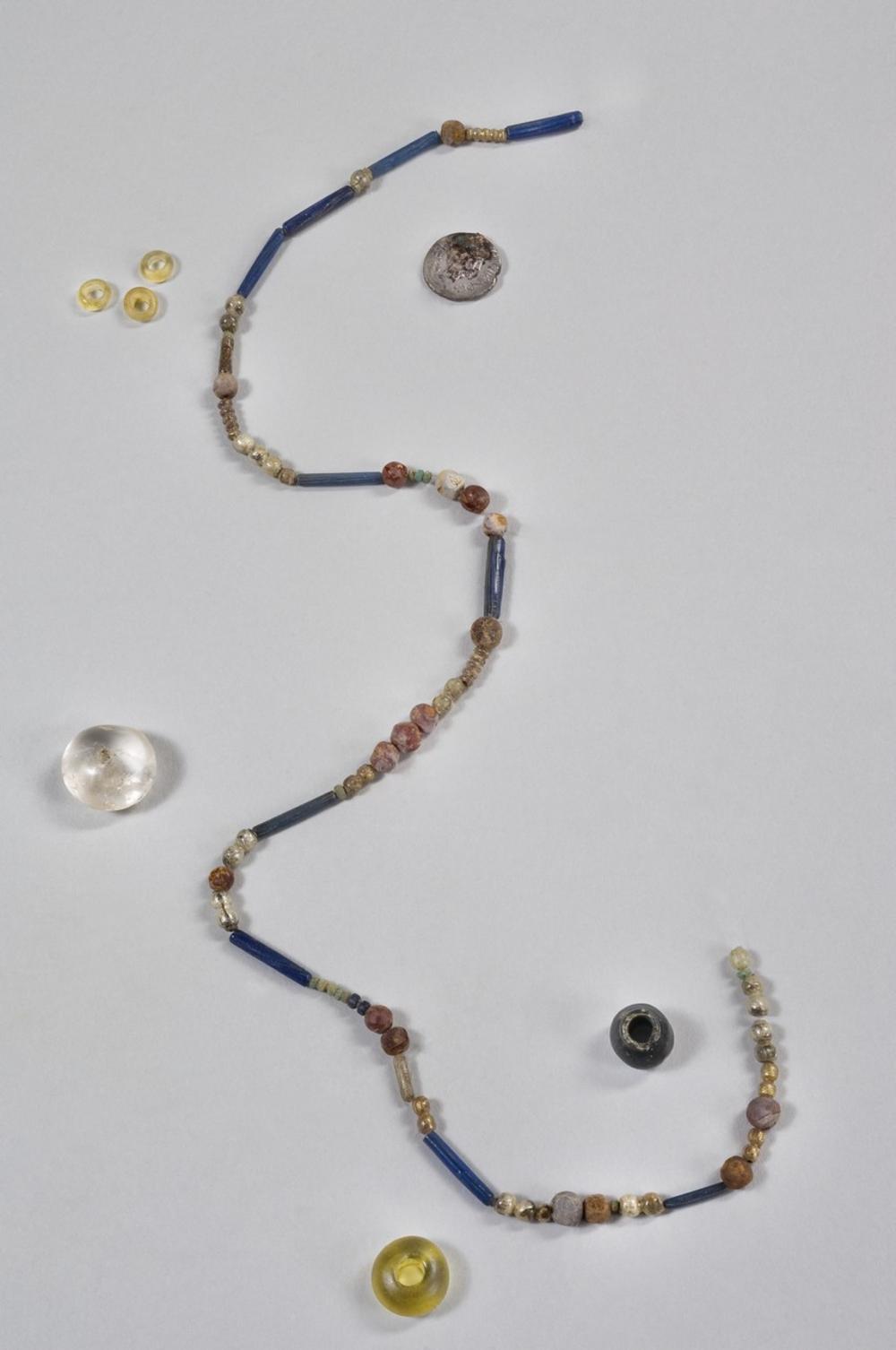
(33/ )
Necklace (67 beads) - Glass beads (19) covered with fish scales, diameter: 0.3 cm (uncut bead chains), some have a surface gilding very different from the appearance of mother-of-pearl; beads not powdery but dull although embedded in a resin. - Tubular glass beads in Egyptian blue (11); L. 20 mm; dia. 3 mm; well preserved, stable beads. There are some iridescence and matte. - Round amber beads (17), dia. 6 mm. The surfaces are powdery with some loss of material and a whitened surface. - Green glass wedding beads (8); diam. 2 mm: surfaces completely pitted, beads very fragile.
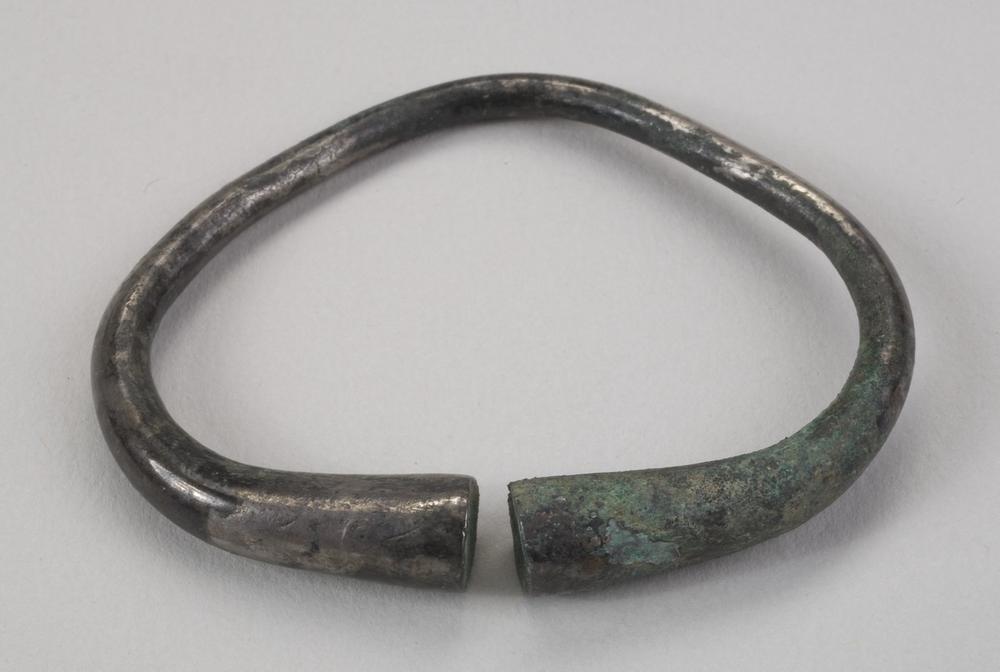
(34/ )
Solid open bracelet with flared ends. Bracelet slightly deformed. Observations : this object is complete. Some tool marks are visible. Remains of skin and hair are present in the copper corrosion products.

(35/ )
This fibula has a cloisonné decoration in silver alloy, with garnets inserted with a double bevel on the edge. These garnets are set on gilded silver pebbles, with a checkerboard pattern. The edges are made of an angle iron that rests on an iron case with no visible attachment. There seems to be a copper alloy sheet to close the partition inside the iron case. On the perimeter of this one, one notes the presence of a damascene of elements in gilded copper. Some pebbles are reversed (front / back). It works in pairs with object 19 from the same burial, even if the motif is not identical on the two fibulae. The two fibulae do not have a completely identical decoration, even if they have the same general characteristics. The composition of the decoration respects an orthonormal scheme, the central field consists of two rectangular garnets joined to form a square. Fibula no. 19 has twelve garnets, two of which are square, two rectangular and four triangular. Fibula no. 3 has a thirteenth additional small garnet, triangular in shape. In addition, the arrangement of the triangular garnets on the two fibulae is not identical. It closed a garment.
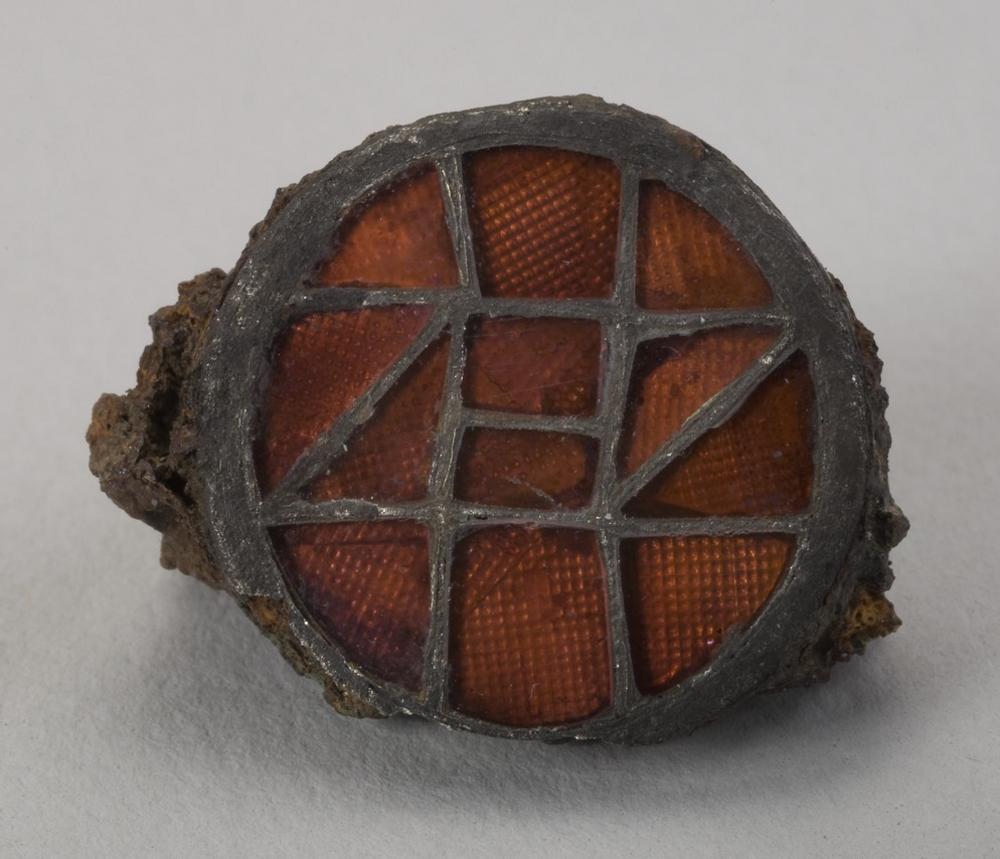
(36/ )
This fibula has a cloisonné decoration in silver alloy, with garnets inserted with a double bevel on the edge. These garnets are set on gilded silver pebbles, with a checkerboard pattern. The edges are made of an angle iron that rests on an iron case with no visible attachment. There seems to be a copper alloy sheet to close the partition inside the iron case. On the perimeter of this one, one notes the presence of a damascene of elements in gilded copper. Some pebbles are reversed (front / back). It works in pairs with object 19 from the same burial, even if the motif is not identical on the two fibulae. The two fibulae do not have a completely identical decoration, even if they have the same general characteristics. The composition of the decoration respects an orthonormal scheme, the central field consists of two rectangular garnets joined to form a square. Fibula no. 19 has twelve garnets, two of which are square, two rectangular and four triangular. Fibula no. 3 has a thirteenth additional small garnet, triangular in shape. In addition, the arrangement of the triangular garnets on the two fibulas is not identical. It closed a garment.
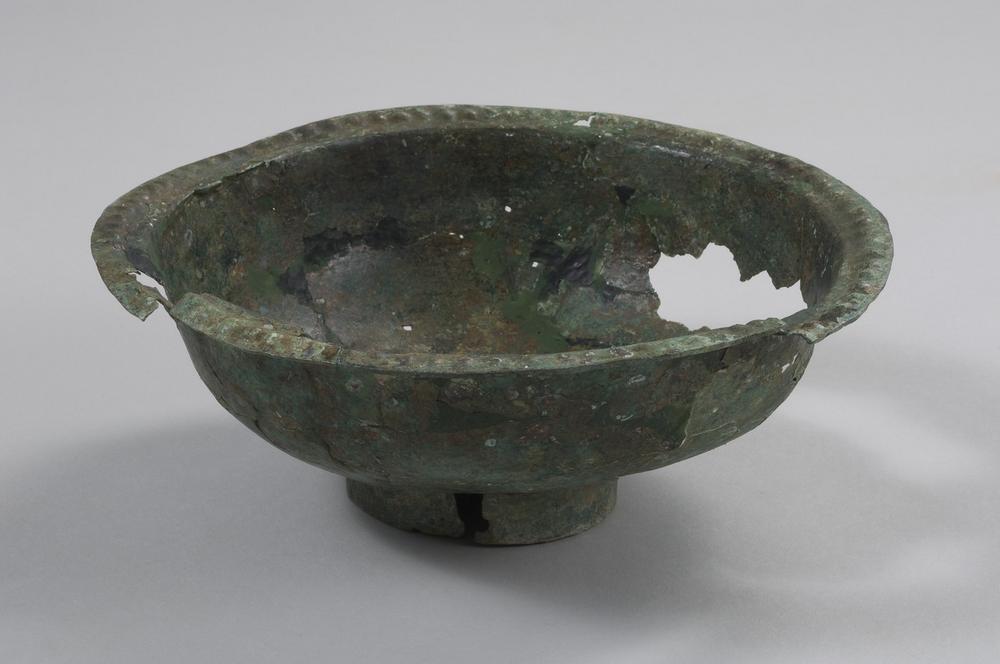
(37/ )
Circular basin with a rim of marli with beaded decoration (86 beads). The spacing between the beads is irregular: 0.5 to 0.2 cm approx. Object made of a sheet of copper alloy cast, hammered and finished on the lathe, with traces visible towards the foot. The edge is beaded by stamping. The foot is a flat cast and rolled strip that was soldered to the reverse of the basin with a lead-tin alloy. The foot has been found but is detached from the rest of the basin. The basin rests on a base that was originally soldered. The edges of the base are not joined. Fleeting traces of textile on the edge.
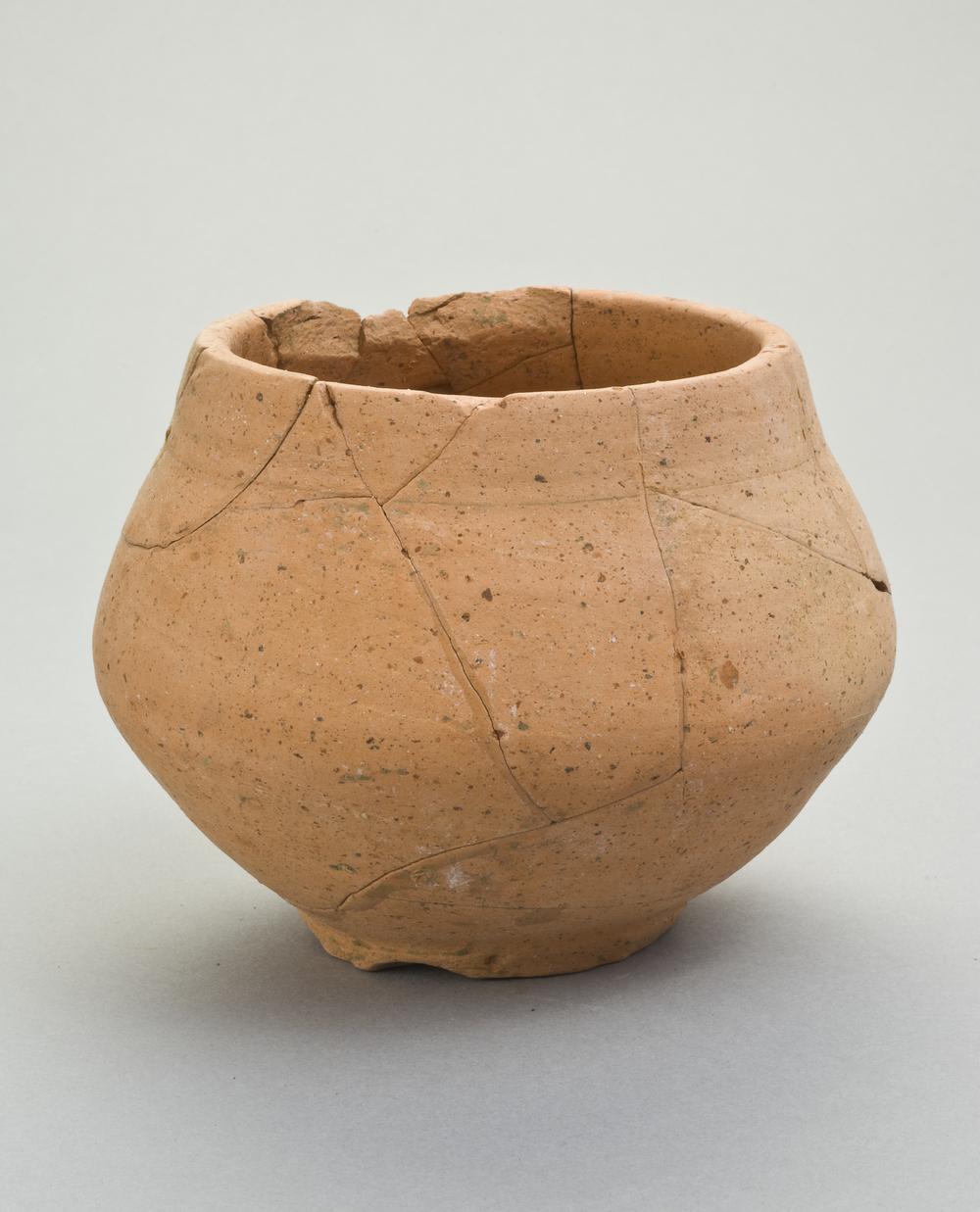
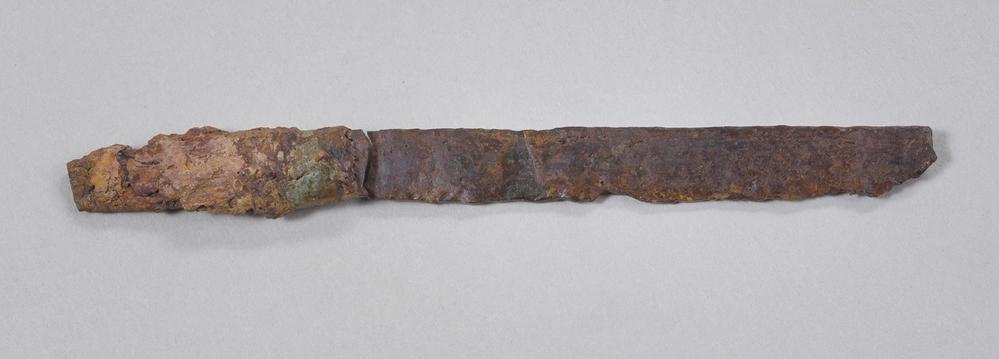
(39/ )
Knife with a flat back and a narrow, straight blade. A ferrule made of copper alloy, rolled up, was supposed to hold the wooden handle of which traces remain around the tang. This object is fragmentary.
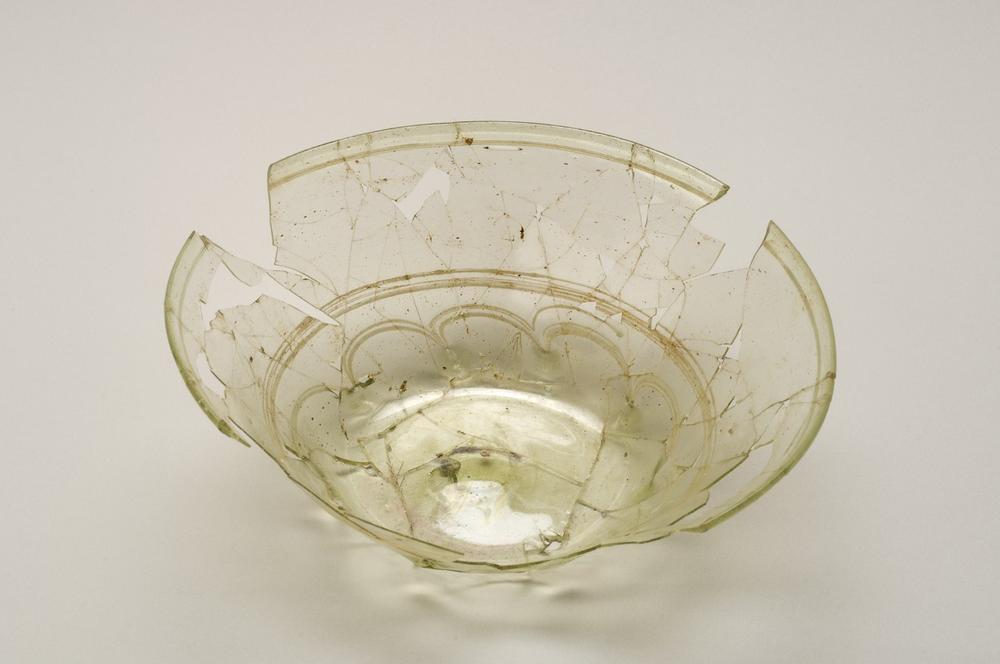
(40/ )
Blown green glass with a white net added.Clear glass cup slightly yellowish, which contains some bubbles and discreet filanders. The lip is round. The walls of the extremely thin body are almost straight to the almost flat bottom with a large tubular pontil mark of 2.2 cm diameter. The glazed decoration is divided into : - Three to four very thin turns of opaque white glass under the lip. - Five to six towers at mid-height of nets of the same nature. - Near the bottom, eight pricked arches formed by five to six turns of very thin white nets stretched downwards and pricked in the material with a pointed instrument. This bowl is identical to bowl 18. It comes from the same workshop.

(41/ )
Campaniform beaker with a transparent greenish glass terminal knob, with many small bubbles. The lip is round and the terminal button is covered with opaque white glass. The decoration is composed of four sets of very fine and tight threads that go up from the bottom to the lip in a spiral movement. The fineness and fragility of the threads means that the white glass has disappeared. It is not a question of filandres but of a decoration voluntarily deposited.
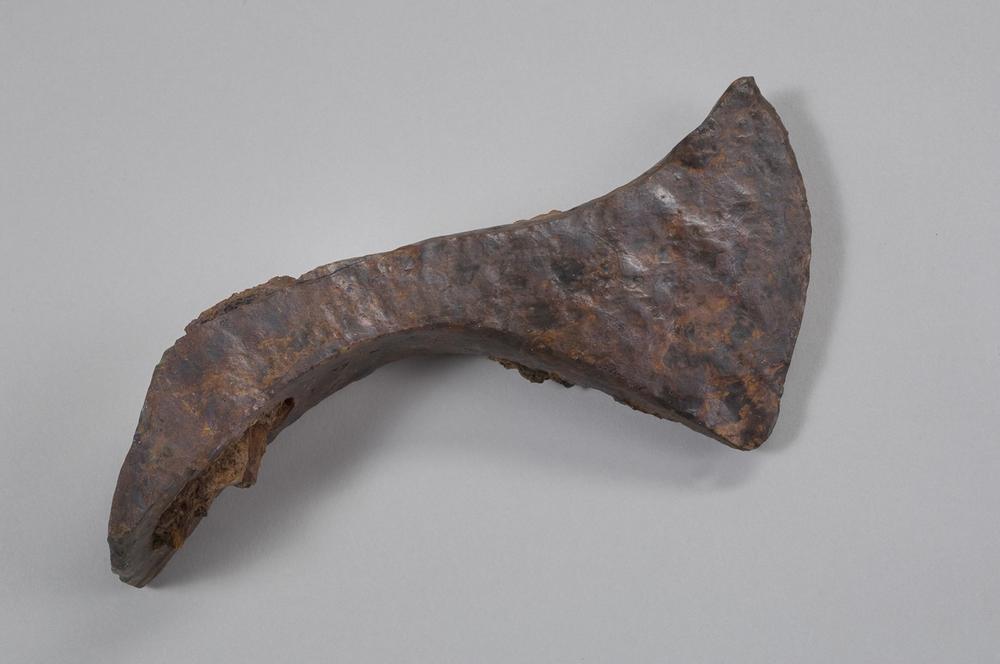
(42/ )
Profiled axe also called francisque. This object is complete. Important remains of textile and leather are present on one face of the axe. Two fragments of corrosion with mineralized textile.
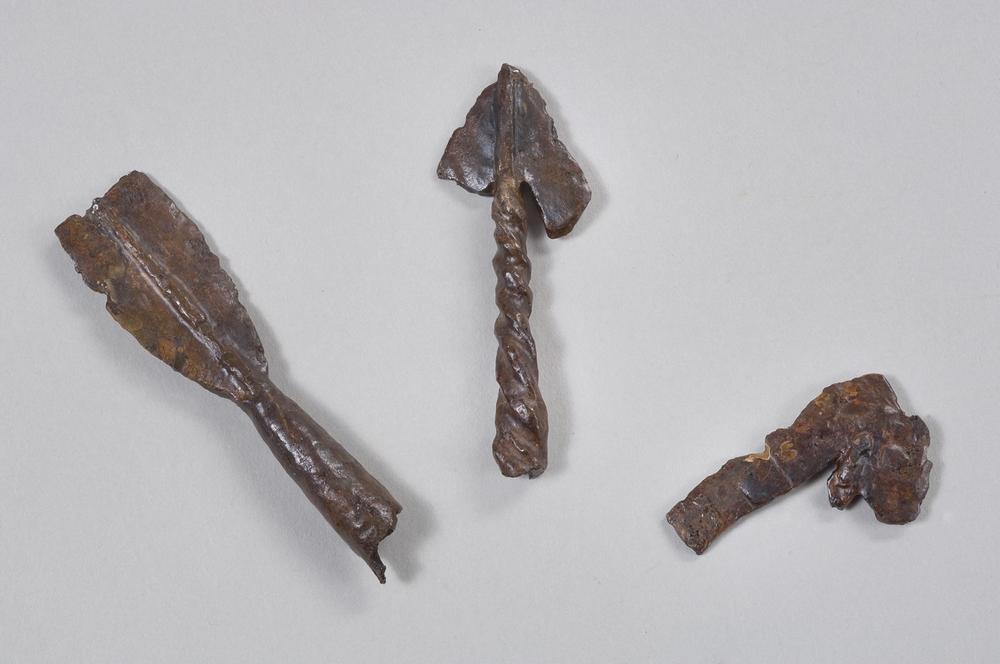
(43/ )
Open socketed arrowhead with oval center ribbed flame. Part of a set of arrowheads collected in a mound under object #15.
(Object on the left of the picture)
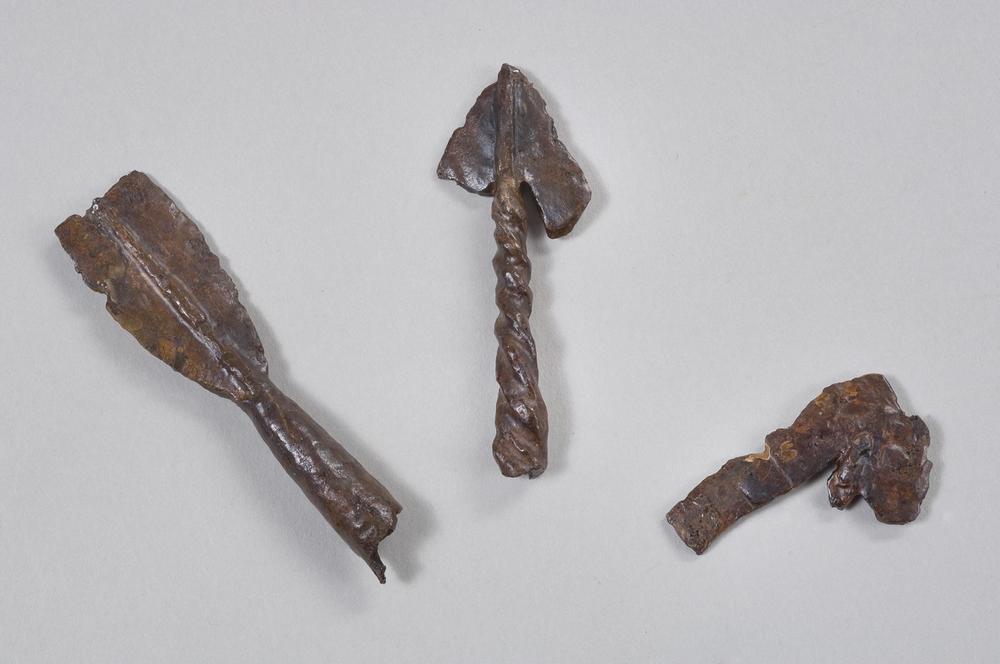
(44/ )
Fragment of a harpoon arrowhead, shaft not preserved. The arrowhead resembles that of object 265, but with a twisted shaft. Part of a group of arrowheads collected in a mound under object no. 15.
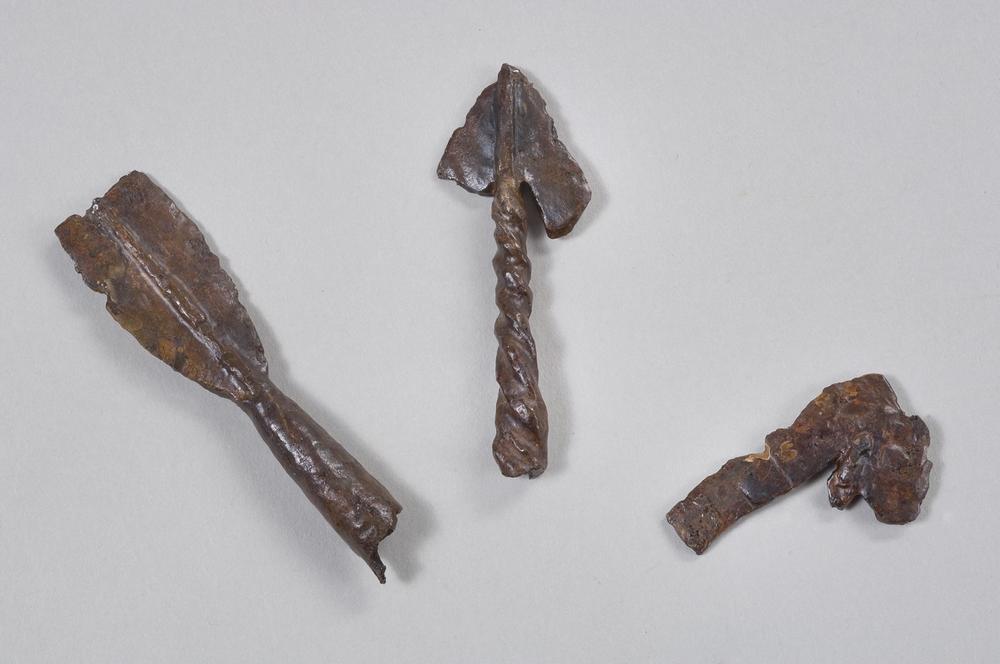
(45/ )
Fragment of arrowhead with harpoon (or barbed) flame and twisted shaft. Part of a set of arrows collected in a mound under object number 15. This object is fragmentary.
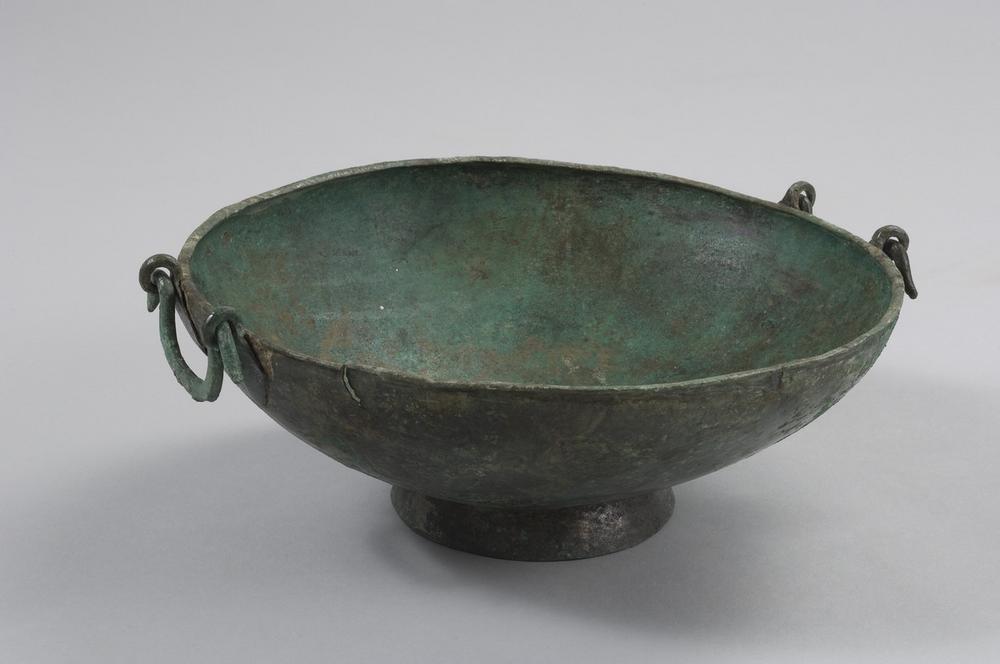
(46/ )
Circular basin with flattened edge on a ringed base. It has two handles decorated with striations and longitudinal beads. They are articulated in two diamond-shaped brackets welded to the body of the basin. Object cast and resumed on the lathe. The handles and the foot are individually cast and soldered with tin. Observations : complete object. Presence of wood covering the bottom of the bowl: formwork board? Thickness about 5 mm.
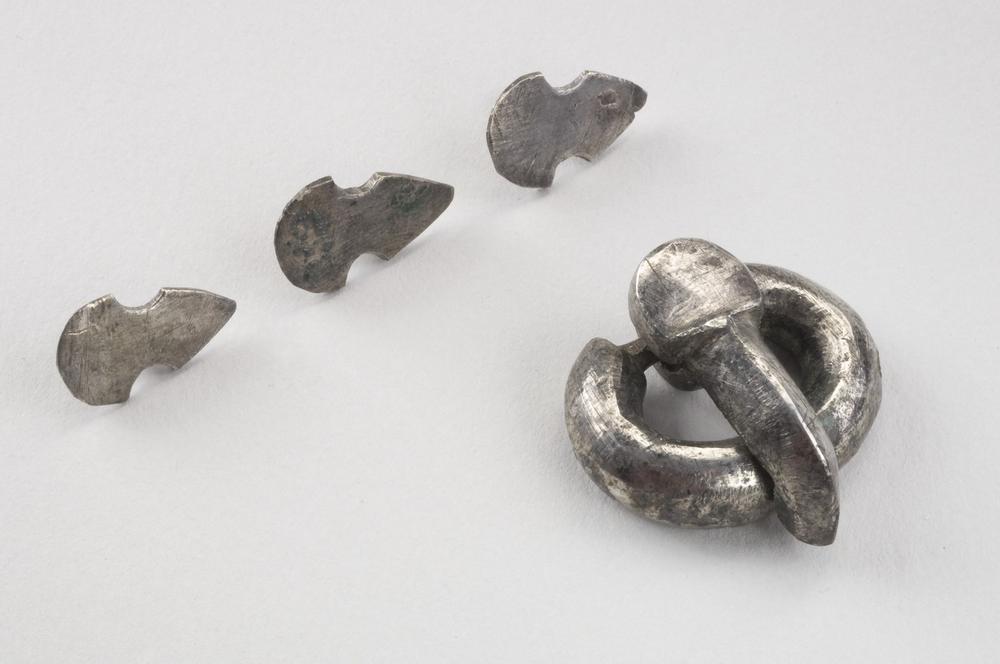
(47/ )
Oval buckle of semi-circular section with a massive scutiform pin and three small scutiform rivets bearing on the reverse a flat section rod pierced by a circular hole. Casting defects are visible on the end of the barb. Rivet 1 : Roughly polished on the visible side. The reverse side is rough cast. The hoop seems to be welded and hammered to form a flat and then drilled. Rivet 2 : A casting defect is visible on the tip. Rivet 3 : The stem is broken at the level of the hole of the hoop. No visible wear on all the elements. This item is complete.
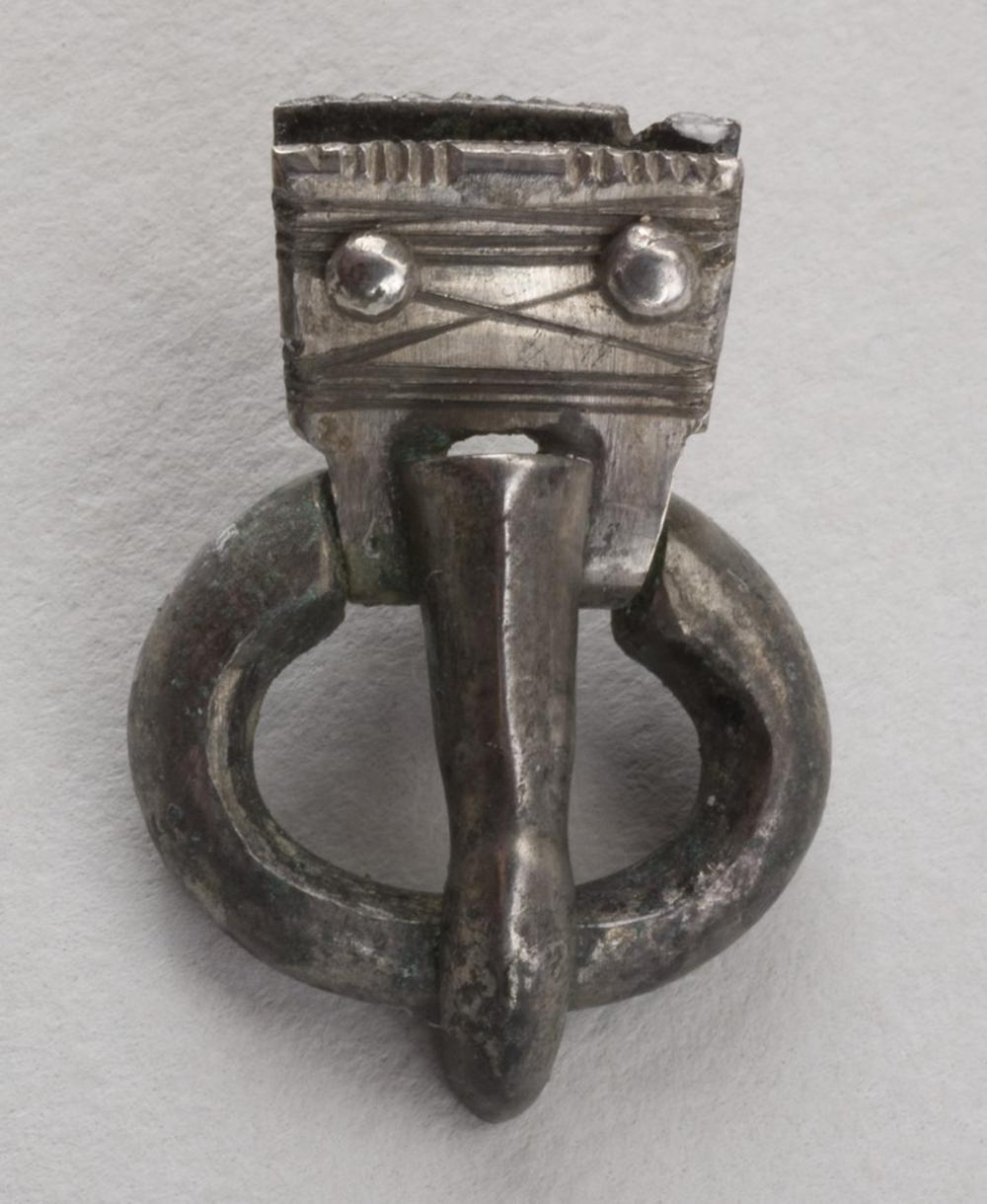
(48/ )
Oval buckle of semi-cylindrical section with an inner side and a truncated cone-shaped barb slightly narrowed in its middle part. The plate, trapezoidal in shape, is made of two silver sheets articulated around the buckle. These plates enclose the leather link by means of two silver rivets with spherical heads. The upper plate is decorated with engraved transverse lines and crosses reminiscent of those found on the mordants (26, 259 and 270 of the same tomb). It is decorated with serrations around the edge. The lower plate is engraved with a St. Andrew's cross and has the same serrations around the edge. This object is very similar to object 24 from the same tomb, without being totally identical in the decoration. Observations: complete object. The cope is decorated with engraved lines. The serrations are filed down. The rivets are preserved.
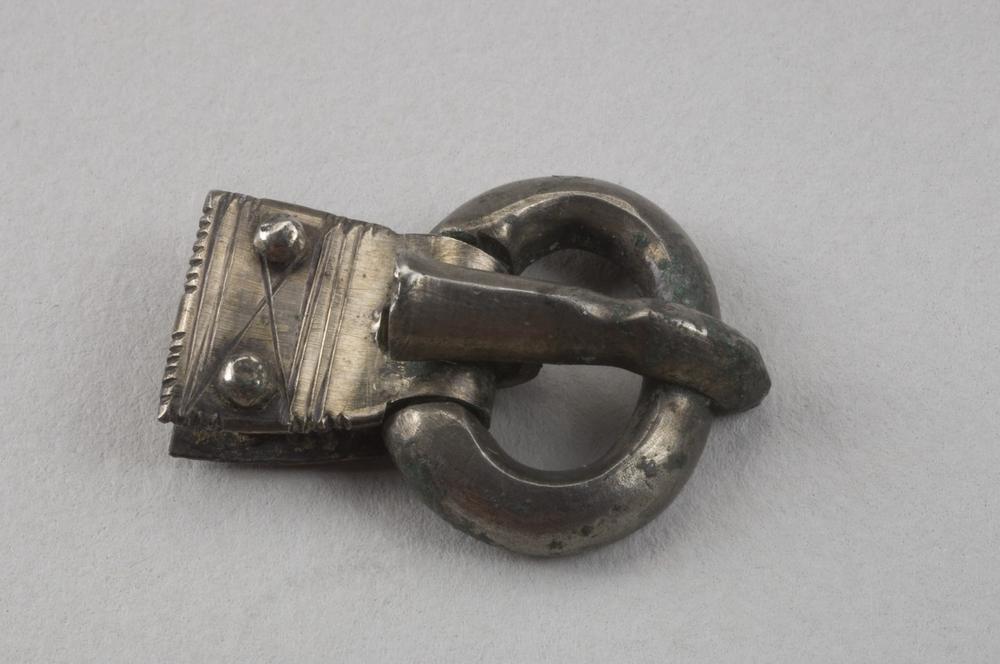
(49/ )
Oval buckle of semi-cylindrical section with a cut inner side and a truncated cone-shaped barb slightly narrowed in its middle part. The plate, of trapezoidal form, is made up of two silver sheets articulated around the buckle. These plates enclose the leather link by means of two silver rivets with spherical heads. The upper plate is decorated with engraved transverse lines and crosses reminiscent of those on the bindings (26, 259 and 270 of the same tomb). The lower plate is engraved with a double cross of St. Andrew and has the same serrations around the edge. This object is very similar to object 22 from the same tomb, without being totally identical in decoration. Observations: The cope has an engraved decoration. The two rivets on the strap are in place.
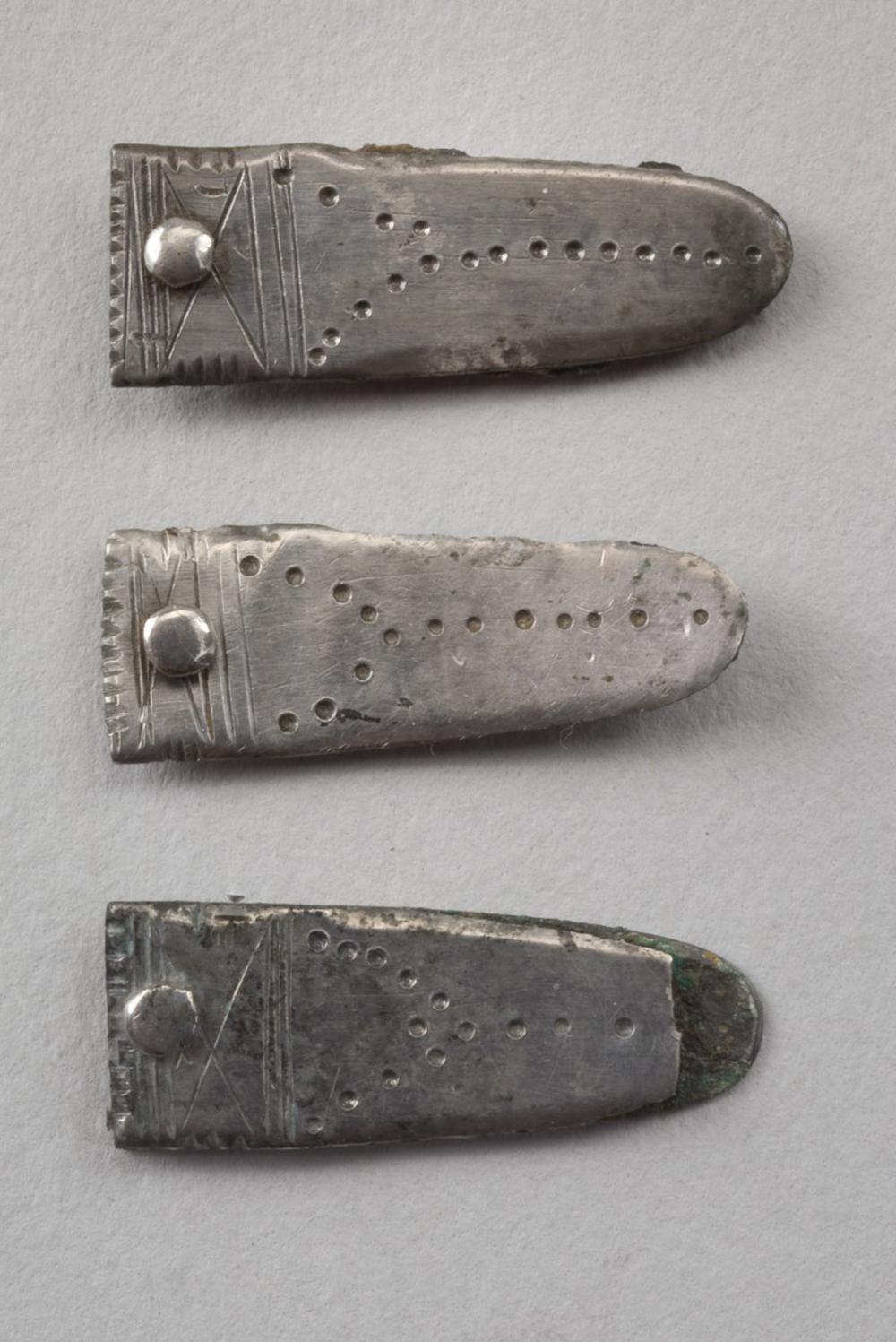
(50/ )
Simple ferret of elongated form made of a silver plate, decorated with an engraved decoration of horizontal stripes at the top underlining a guilloche edge. The middle part is decorated with small engraved points. A rivet is preserved. It is intended to fix the silver plate to another, missing. Observations : Engraved decoration on the face. The reverse is a copper alloy plate. This object is complete.

(51/ )
Simple ferret of elongated form made of a silver plate, decorated with engraved horizontal stripes at the top underlining a guilloche edge. The middle part is decorated with small engraved points. It is intended to fix the silver plate to another, missing. Observations : incomplete object. Presence of an engraved decoration.
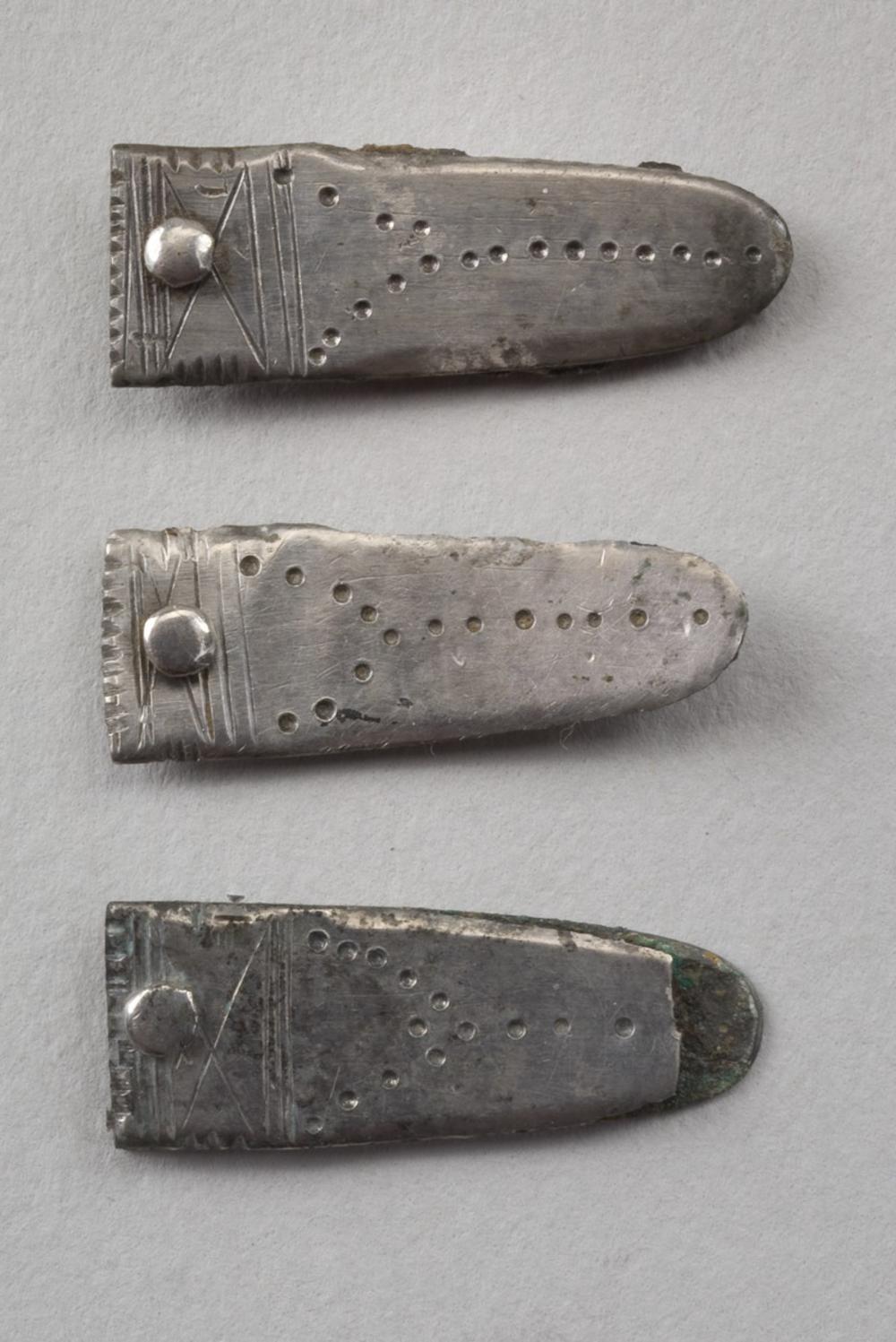
(52/ )
Simple ferret of elongated form made up of two silver sheets connected by a silver rivet. One of the sheets is decorated with an engraved horizontal stripe and cross at the top highlighting a guilloche edge. The middle part is decorated with small engraved dots. This object is complete.
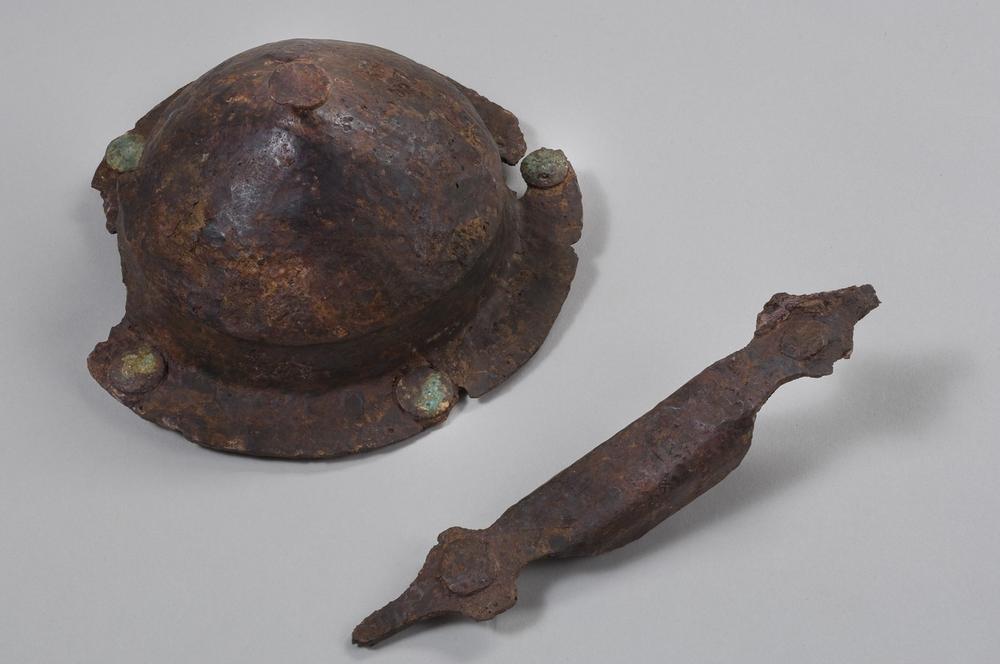
(53/ )
The handle is made of a thin metal sheet, maintained by two iron rivets with flat circular heads. Traces of wood on the back of the rivets and in the hollow part of the handle. The wood in the hollow part of the handle may correspond to a wooden handle (covered with leather?). Two fragments of stems with a rectangular section could be fragments of a branch or of a maniple. One of these branches is repaired by riveting. Traces of tin solder on the reverse.
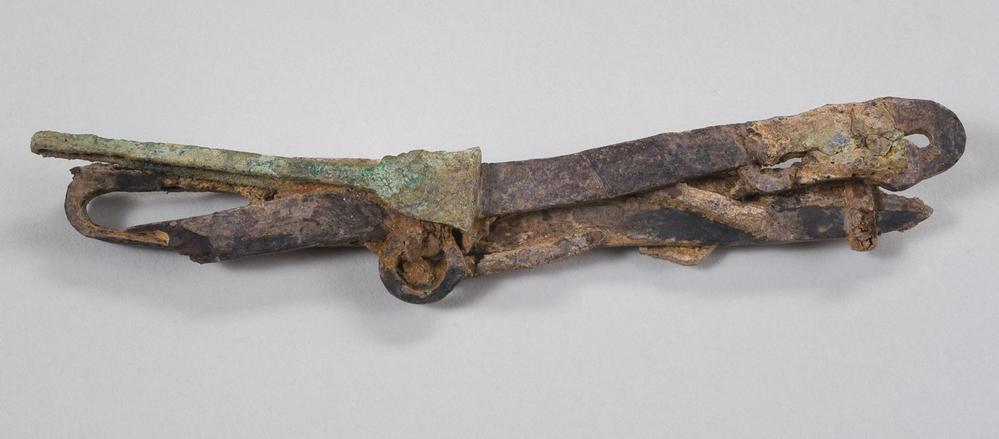
(54/ )
Complete tweezers in copper alloy. The edges of the paddle are cut out.
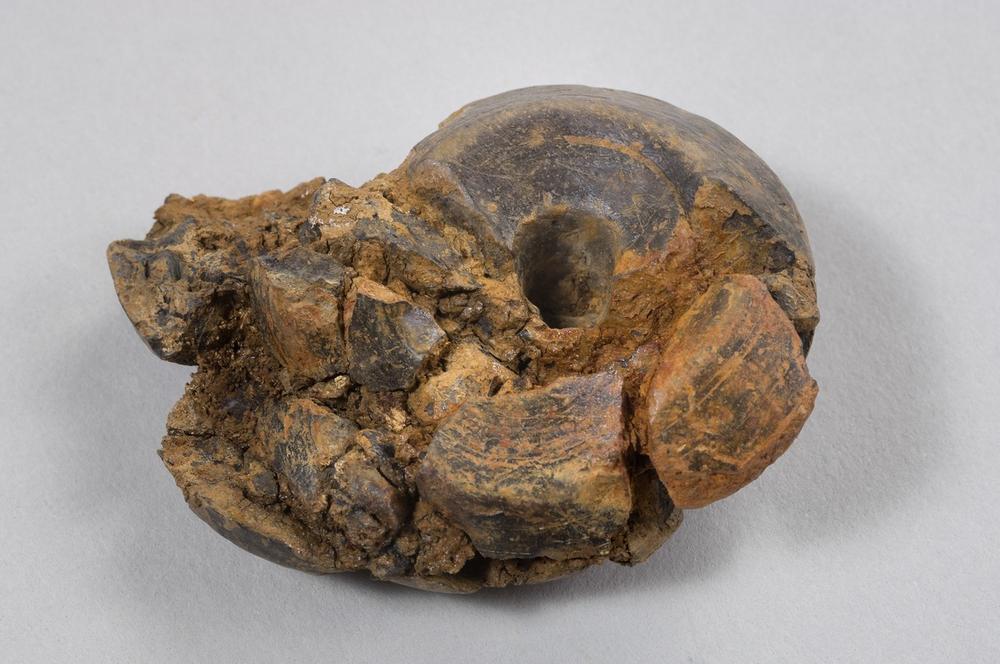
(55/ )
Pearl crushed in place of truncated biconical shape. This type of bead is often found in male tombs in association with a sword or a scramasaxe and undoubtedly has a prophylactic virtue. Observations: fragmentary object. Traces of turning are visible on the surface.
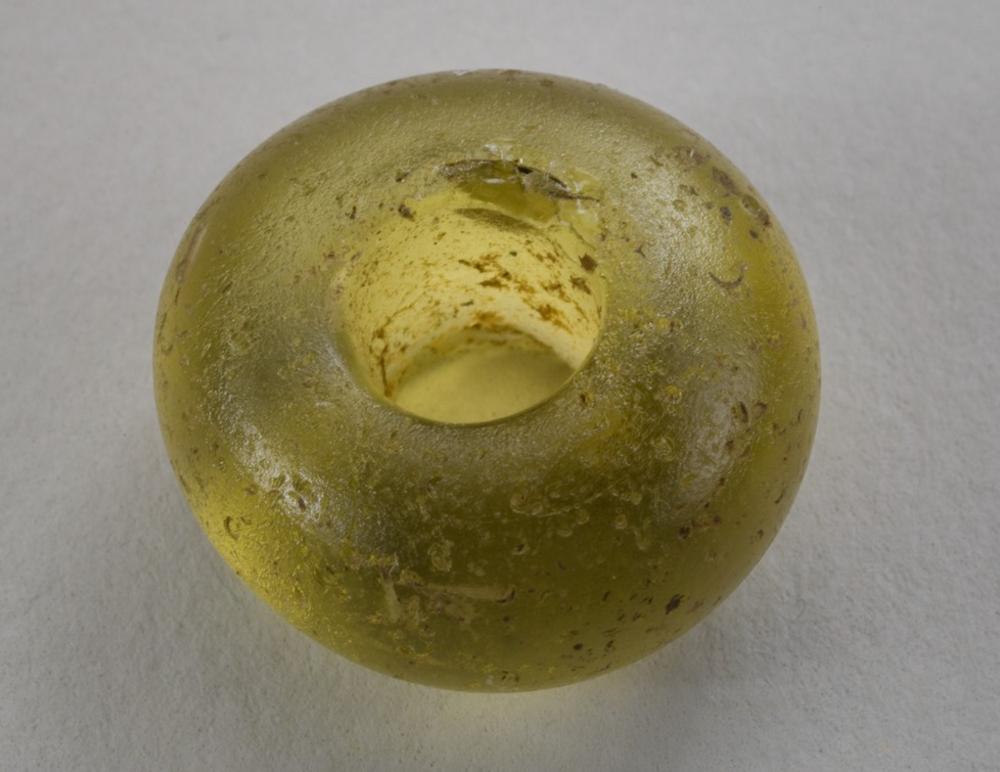
(56/ )
Translucent yellow pearl with a semi-cylindrical section originally connected by a copper alloy wire with a cylindrical section

(57/ )
Very dark green transparent glass bead, called black glass (see black glass of ganobi)